Take Me to The Recipes
Imagine, if you will, a vibrant tapestry woven from threads of spice, heritage, and tradition. This tapestry, embroidered with influences from Malay, Chinese, Indian, and indigenous communities, represents the essence of Malaysia. But it’s not just visually stunning; it’s an explosion of flavor waiting to be explored. Buckle up for a culinary adventure through Malaysia, where every bite tells a story, every aroma unveils a cultural encounter, and every dish paints a picture of a nation’s diverse and delicious identity.
From the fiery curries of the Nyonya tradition to the melt-in-your-mouth satay skewers, Malaysian cuisine is a testament to its rich, multicultural heritage. Influences from neighboring countries and centuries of trade have created a unique gastronomic landscape where sweet meets savory, fiery chilies tango with fragrant herbs, and textures range from melt-in-your-mouth to delightfully crunchy.
Dive into bustling night markets overflowing with steaming hawker stalls, discover hidden family recipes passed down through generations, and embark on a journey through Malaysia’s vibrant culinary landscape – an experience that will tantalize your taste buds and leave you yearning for more.
So, are you ready to embark on this delectable adventure? Join us as we unravel the secrets of Malaysian cuisine, exploring its history, diverse influences, and signature dishes. Get ready to be surprised, delighted, and inspired by the flavors that define this extraordinary nation.
Take Me to The Recipes
Key Takeaways
- Malaysian cuisine is characterized by its diversity, drawing from Malay, Chinese, and Indian influences primarily.
- The dishes highlight Malaysia’s rich history and geographical diversity.
- Street foods play a significant role in Malaysian gastronomy.
Where is Malaysia?

Malaysia, country of Southeast Asia, lying just north of the Equator. It is composed of two regions: Peninsular Malaysia (Semenanjung Malaysia), also called West Malaysia (Malaysia Barat), which is on the Malay Peninsula, and East Malaysia (Malaysia Timur), which is on the island of Borneo.

Index to this Article
- Take Me to The Recipes
- More Articles
- Interesting Facts About Malaysia
- Historical Influences on Malaysian Cuisine
- Geographical Influences on Malaysian Cuisine
- Understanding the Essence of Malaysian Food Culture
- Malaysian Culinary Traditions
- How Healthy is Malaysian Cuisine?
- Traditional Malaysian Dishes
- Popular Food in Malaysia
- National Dish of Malaysia – Nasi Lemak
- Malaysian dishes you can Try at Home
- Street Food in Malaysia
- Conclusion
- A Delectable Q&A Session
You may also be interested in the following articles
- North and South American Cuisine – A Culinary Expedition
- Europe Cuisine: Savor the Continent’s Best Culinary Secrets!
- African Cuisine: Discover the Bold Flavors & Global Charm!
- Asian Cuisine Unlock its Secrets – Taste, Health & Global Influence!
Savor iconic Malaysian Recipes – Click on each tantalizing Image to open up the Recipe
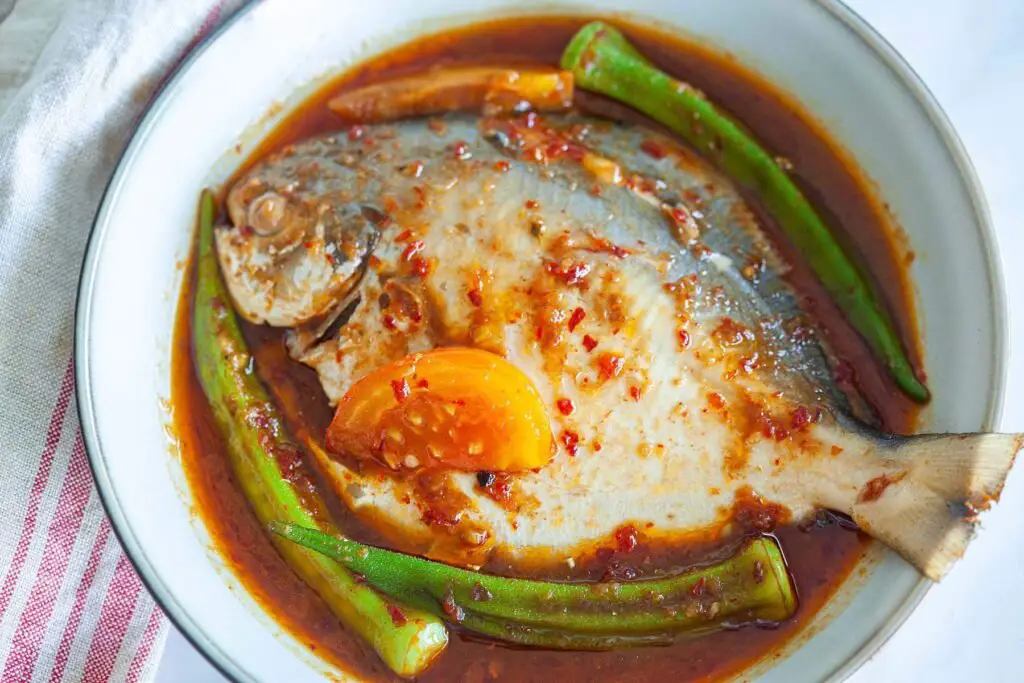
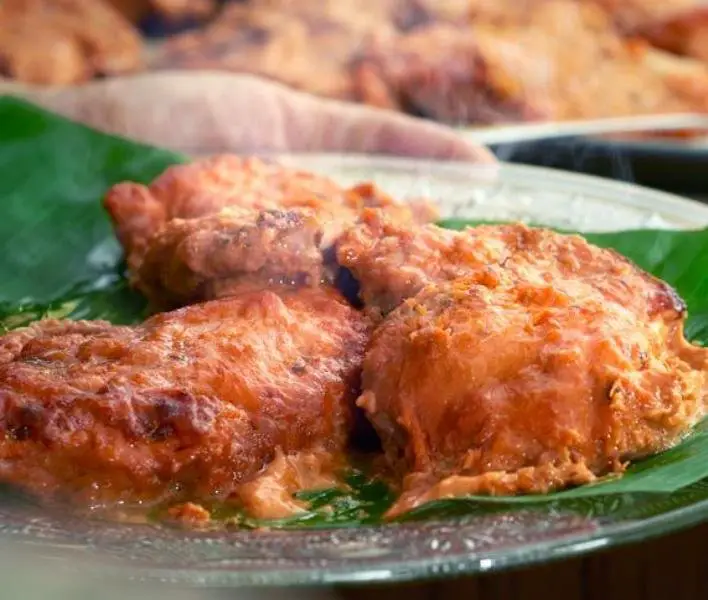
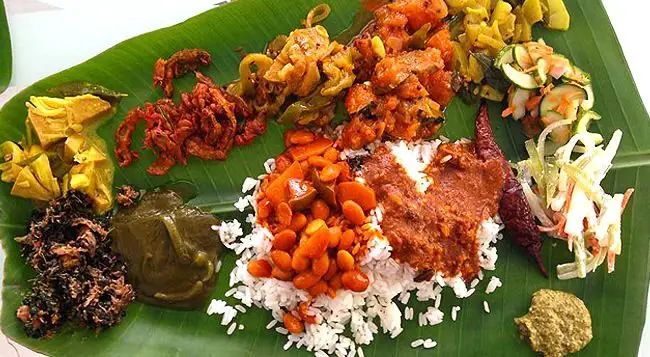




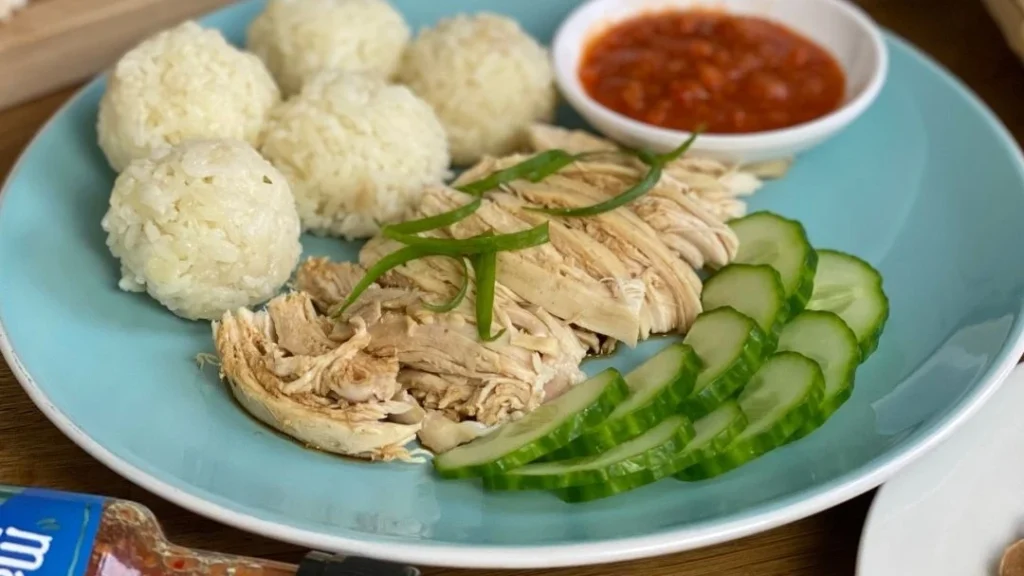
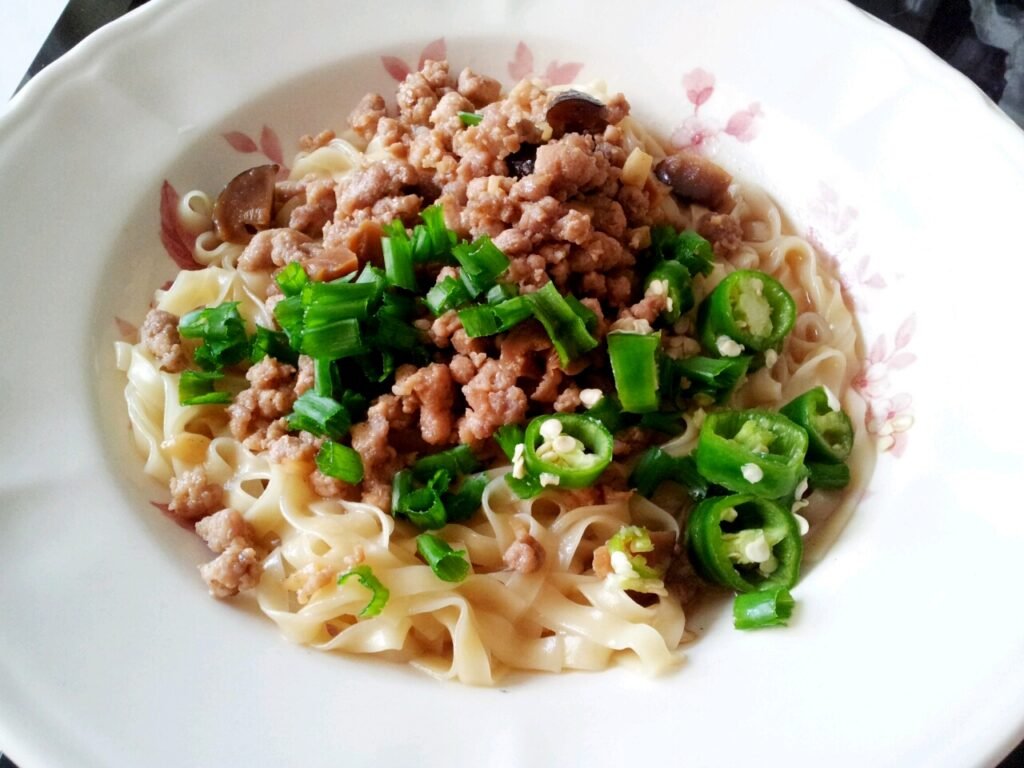
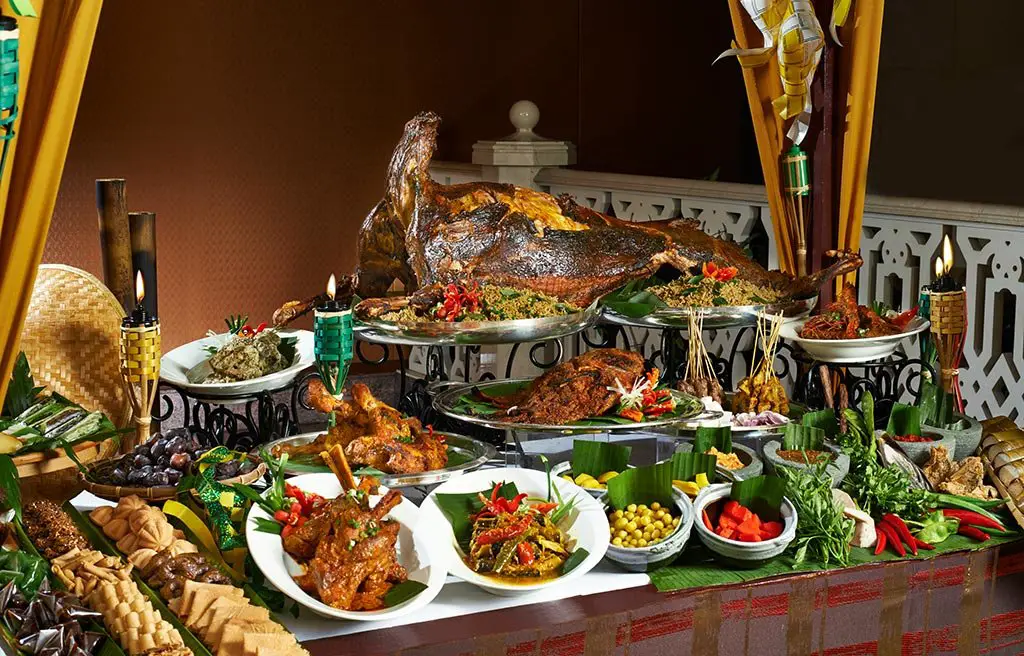

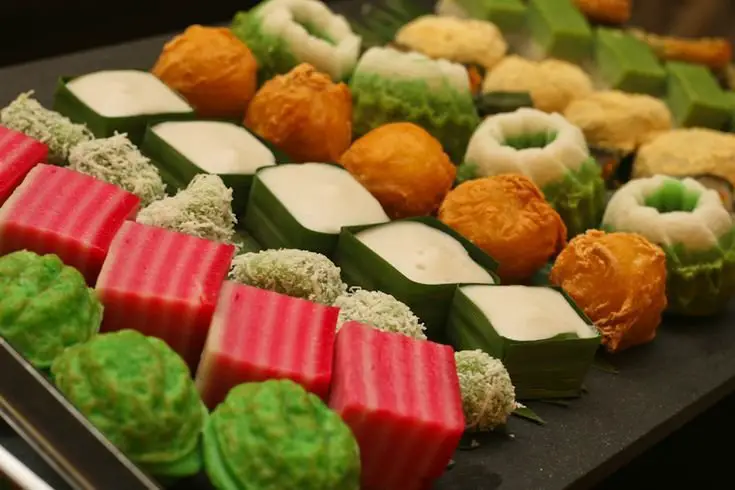

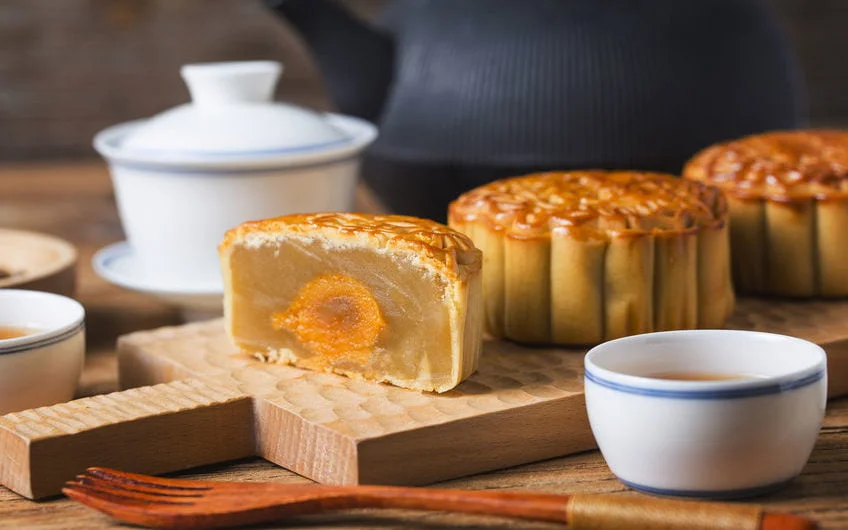
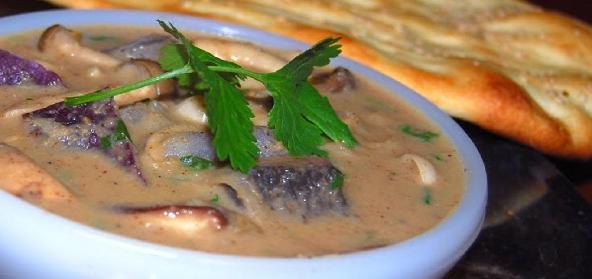
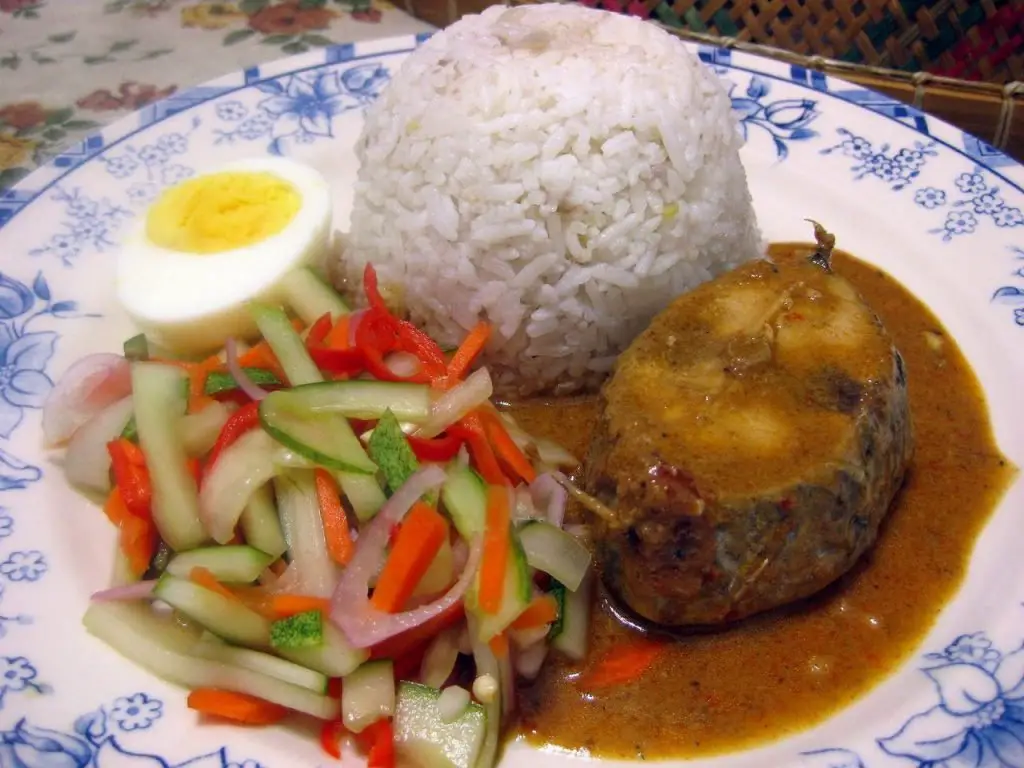
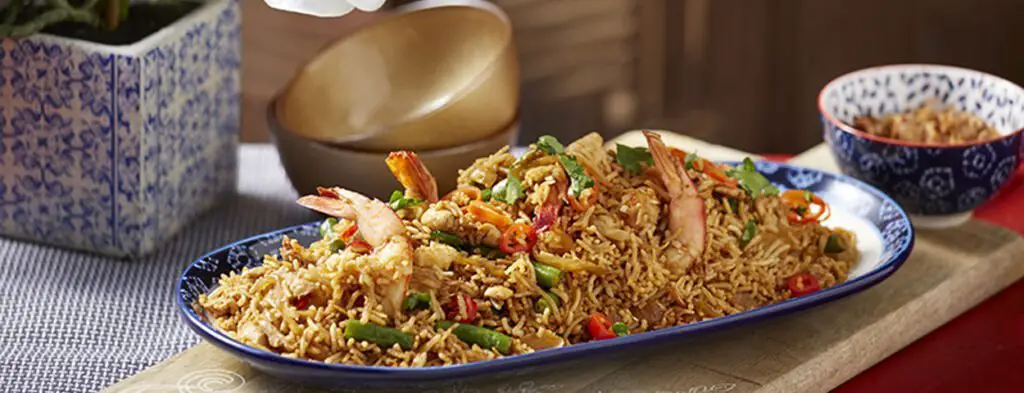



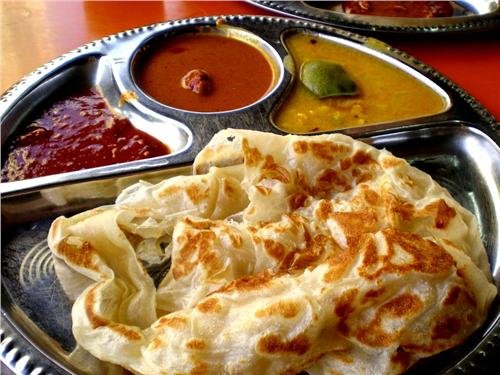
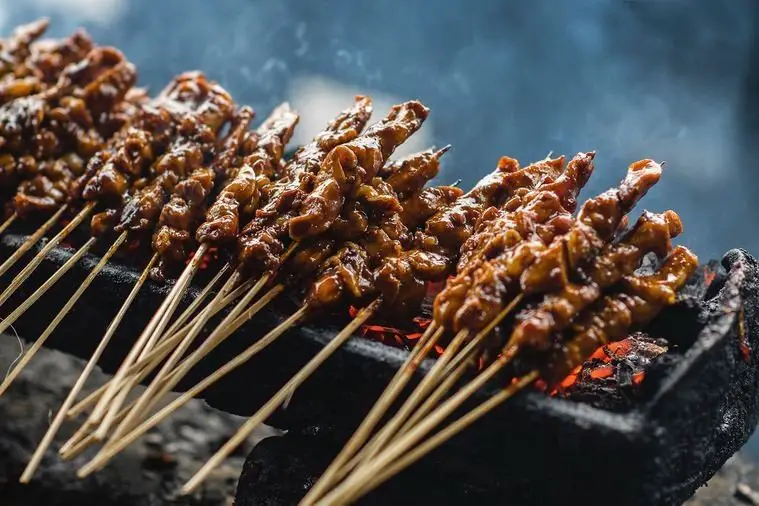
- National Dish of Malaysia – Nasi Lemak
- Popiah
- Kerabu Mangga (Mango Salad)
- Rendang
- Char Kway Teow
- Laksa
- Curry Laksa (Nyonya Laksa or Laksa Lemak)
- Cendol
- Bubur cha cha
10 Intriguing Bites of Malaysia: Facts Beyond the Tourist Brochure
World’s Tallest Twin Towers (Formerly)

The iconic Petronas Towers held the title of the world’s tallest buildings from 1998 to 2004, standing proudly at 451.9 meters. Though no longer top dog, they remain a breathtaking symbol of Malaysia’s modern architecture.
Shoe Capital of Southeast Asia

Forget Cinderella, think Jimmy Choo! This world-famous shoe designer hails from Penang, Malaysia, putting the country on the map for high-end footwear fashion.
National Monkey Business

Beware of mischievous long-tailed macaques! These cheeky primates inhabit many Malaysian forests and urban areas, known for snatching food and posing for (questionable) selfies with tourists.
World’s Largest Cave Chamber

Spelunking enthusiasts, take note! Sarawak Chamber in Ganung Mulu National Park is the world’s largest known cave chamber, with enough space to fit 50 Boeing 747s!
Rafflesia: The Corpse Flower
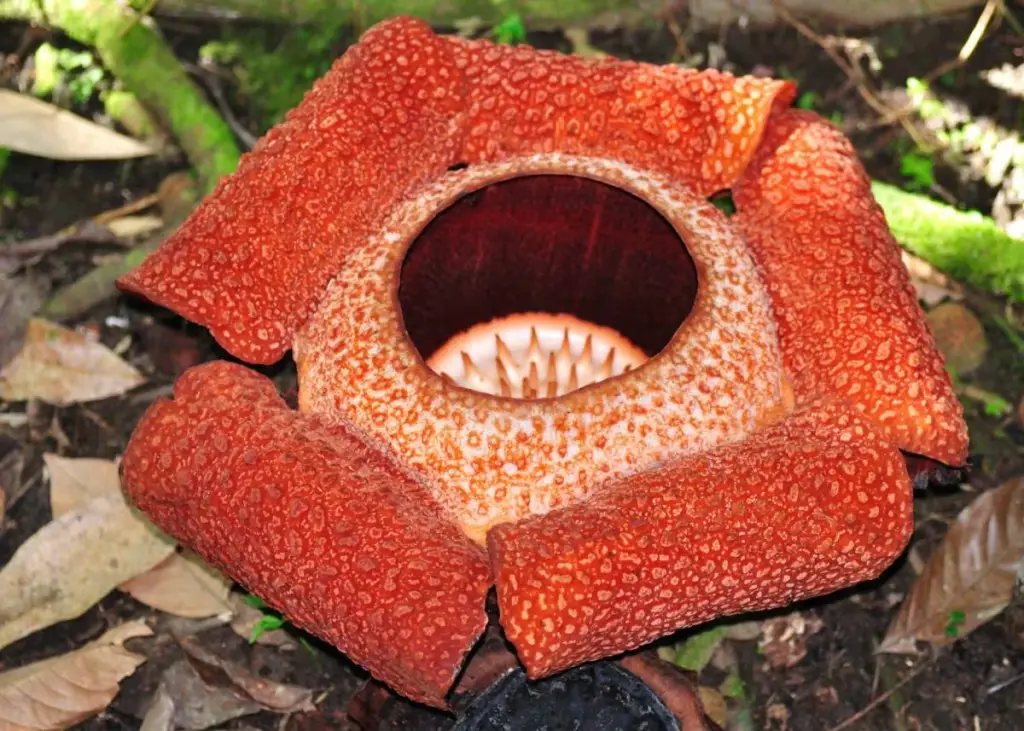
Prepare for a stench-tastic experience! The Rafflesia arnoldii, native to Borneo, holds the title of the world’s largest flower, reaching up to 3 feet in diameter. However, its beauty comes at a cost – it emits a pungent odor resembling rotting flesh to attract flies for pollination.
Island Hopping Extravaganza

With over 878 islands, Malaysia is a paradise for beach lovers. Explore pristine beaches, diverse marine life, and vibrant island cultures, each with its own unique charm.
Home to the Orangutan

The rainforests of Borneo, shared by Malaysia, are the only remaining natural habitat for these critically endangered primates. Spotting one in its natural habitat is an unforgettable experience.
UNESCO World Heritage Sites Galore
History buffs rejoice! Malaysia boasts 13 UNESCO World Heritage Sites, ranging from ancient archaeological sites to colonial-era architecture and stunning natural landscapes.
King on Rotation

Unlike most monarchies, Malaysia operates on a unique system where the nine state sultans take turns acting as king for five-year terms. This rotation ensures equal representation and strengthens national unity.
Spicy, Sweet, and Everything in Between
Malaysian cuisine is a delicious adventure for your taste buds. From fiery curries to fragrant satays, refreshing noodle soups to melt-in-your-mouth desserts, prepare to be amazed by the diversity and depth of flavors.
These are just a few of the many intriguing facts that make Malaysia such a fascinating place to visit. So, whether you’re a foodie, a history buff, or simply seeking a unique adventure, Malaysia has something to offer everyone.
A Fusion Feast: How History Seasoned Malaysia’s Cuisine
Malaysia’s vibrant cuisine, like its rich tapestry of cultures, is a delicious echo of the diverse influences that have shaped the nation. Let’s embark on a historical journey through flavors, exploring how each period left its mark on the Malaysian plate:
Early Encounters (Before 1500)

Indigenous Spice Trails: From foraging communities emerged the use of local spices like ginger, turmeric, and galangal, forming the base of Malay cuisine. Dishes like “laksa” and “rendang” still showcase these aromatic foundations.
Rise of Trade Empires (1500-1800)
Spice Trade Boom: Portuguese, Dutch, and British traders brought in new ingredients like chilies, onions, and garlic, adding heat and complexity to Malay cooking. The iconic “Nasi Lemak” (coconut rice) and “Satay” (skewered meat) were born during this era.
Chinese Migration: Chinese immigrants introduced noodles, stir-frying techniques, and ingredients like soy sauce and tofu, influencing dishes like “Char Kway Teow” and “Hakka Mee.”
Colonial Era (1800-1957)

British Influence: Tea plantations led to the adoption of afternoon tea traditions, while Indian laborers brought curries and roti, enriching the culinary landscape further. Dishes like “Curry Laksa” and “Roti Canai” reflect this fusion.
Post-Independence (1957-Present)

National Identity: With independence, chefs sought to define a national cuisine, blending Malay, Chinese, and Indian influences. “Nasi Goreng” (fried rice) emerged as a beloved national dish.
Modern Fusion: Globalization has brought new ingredients and techniques, leading to innovative fusion dishes like “Nyonya Cendol” (dessert with coconut milk and pandan) and “Malaysian Burgers.”
Beyond History
While history provides a framework, understanding Malaysian cuisine goes beyond dates and empires. It’s about:
Regional Variations: Each state boasts its own culinary specialties, reflecting local ingredients and traditions. Think Penang’s “Char Koay Teow” or Kelantan’s “Nasi Dagang.”
Street Food Culture: Vibrant hawker stalls are the heart and soul of Malaysian cuisine, offering affordable and diverse options.
Communal Dining: Sharing meals is deeply ingrained in Malaysian culture, fostering connection and celebration.
Malaysia’s cuisine is a living testament to its multicultural heritage, continuously evolving with each generation. So, the next time you savor a plate of “Nasi Lemak” or slurp down a bowl of “Laksa,” remember – you’re not just enjoying a meal, you’re experiencing a delicious journey through Malaysian history and culture.
Geographical and Climatic Influences on Malaysian Cuisine
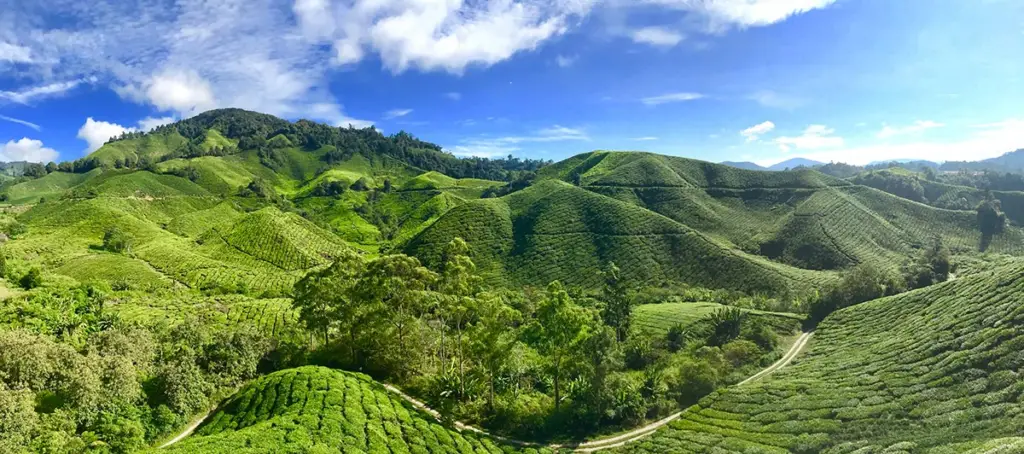
Malaysian cuisine is a reflection of the multi-ethnic population of Malaysia, which can be roughly divided into three major ethnic groups: Malays, Chinese, and Indians.
The cuisine is a melange of traditions from Malay, Chinese, Indian, Indonesian, Filipino, and indigenous Bornean and Orang Asli, with influences from Arab, Thai, Portuguese, Dutch, and British cuisines, among others.
The condiments, herbs, and spices used in cooking vary, and the cuisine is highly complex and diverse.
The geographical and climatic influences on Malaysian cuisine are significant. Malaysia’s tropical climate and abundant rainfall have resulted in a rich variety of fruits and vegetables, including durian, rambutan, jackfruit, and mangosteen, which are used in many dishes.
- The coastal regions of Malaysia are known for their seafood dishes.
- The interior regions are known for their meat dishes, such as rendang, a spicy beef dish. The mountainous regions of Malaysia are known for their tea plantations, which produce high-quality tea.
In conclusion, Malaysian cuisine is a fusion of diverse culinary cultures that have developed over the region’s history. The cuisine is influenced by the country’s multi-ethnic population, as well as its geographical and climatic conditions. The result is a complex and diverse cuisine that is a reflection of Malaysia’s rich cultural heritage.
References
Understanding the Essence of Malaysian Food Culture

Malaysian Food Culture is a captivating blend of flavors, an embodiment of its rich tapestry of cultures. With roots deeply intertwined with Malay, Chinese, Indian, Thai, Javanese, and Sumatran influences, the essence of Malaysian food is its diversity and harmony in fusion.
Central to Malaysian cuisine is rice, the staple grain, often served with sambal, a spicy chili paste, or accompanied by ‘rendang’, a slow-cooked dry curry deeply spiced and rich in coconut milk.
The ubiquitous ‘nasi lemak’, often considered the national dish, encapsulates this essence perfectly. Fragrant rice cooked in coconut milk, paired with sambal, crispy anchovies, roasted peanuts, boiled egg, and cucumber showcases the multifaceted flavors and textures that Malaysian cuisine champions.
However, the culinary landscape extends beyond just rice dishes. The bustling streets of cities like Penang and Kuala Lumpur teem with hawker stalls, each offering a symphony of tastes. From the ‘char kway teow’ (stir-fried rice noodles) to the ‘roti canai’ (Indian-influenced flatbread), the influences from different ethnic groups are evident.
Yet, it’s not just about the intermingling of flavors from various cultures. Malaysian cuisine is a celebration of its abundant natural resources. From the fresh seafood of its extensive coastline to the exotic fruits from its tropical rainforests, the land’s bounty plays a significant role in shaping its food.
Furthermore, the essence of Malaysian cuisine lies in its communal nature. Meals are often shared, with dishes placed in the center for everyone to partake. This practice underlines the Malaysian ethos of ‘gotong-royong’ or communal helping and sharing.
In essence, to understand Malaysian Food Culture is to embrace its harmonious diversity, its rooted traditions, and its spirit of community. It’s a journey of flavors, where each dish narrates a story of unity in diversity.
Malaysian Culinary Traditions

Malaysia’s culinary realm is a fascinating confluence of age-old traditions, ceremonies, and daily rituals that have stood the test of time. These traditions not only highlight the rich history but also reflect the harmonious coexistence of its diverse communities.
One of the most cherished traditions is the ‘kenduri’, a Malay feast held during significant occasions such as weddings, anniversaries, or religious celebrations. Central to a kenduri is the ‘nasi minyak’, glistening rice cooked with ghee and accompanied by a plethora of side dishes, from rendang to tangy pickles.
During the month of Ramadan, the evening ‘buka puasa’ (breaking the fast) becomes a sacred culinary ritual. As the muezzin calls out the Maghrib prayers, families gather to break their fast with dates and ‘air bandung’, a sweet rose-tinted milk drink, followed by a spread of traditional dishes like ‘ayam percik’ (grilled spiced chicken) and ‘serunding’ (meat floss).
The Chinese community in Malaysia, with their lunar calendar, brings forth traditions like the Mid-Autumn Festival. Mooncakes, with their intricate designs and fillings ranging from red bean to lotus paste, become the centerpiece of celebrations.
For the Indian Malaysians, the ‘banana leaf meal’ is a revered tradition. Rice and an array of curries are served on a large banana leaf, signifying purity, with diners using their hands to eat, melding tactile sensations with gustatory delights.
Each region in Malaysia also has its unique traditions. From the ‘laksa’ wars of Penang and Sarawak to the ‘sata’, a fish cake from Terengganu wrapped in banana leaves and grilled, regional pride is evident in culinary expressions.
In essence, Malaysian culinary traditions are a vibrant dance of flavors, colors, and textures. They are a testament to the nation’s shared history, communal bonds, and the rich tapestry of cultures that call Malaysia home.
Malaysian Cuisine: A Balancing Act Between Flavor and Health?

Malaysian cuisine is renowned for its vibrant flavors and unique blend of influences, but how healthy is it? The answer, like the cuisine itself, is complex and nuanced.
Strengths
- Variety: Malaysian cuisine boasts an incredible variety of ingredients, including fruits, vegetables, whole grains, and lean protein sources like fish and poultry. This diversity promotes balanced nutrition and allows for individual dietary needs and preferences.
- Traditional Cooking Methods: Many traditional cooking methods like steaming, stir-frying, and grilling involve minimal oil, preserving nutrients and reducing unhealthy fats.
- Spices and Herbs: Malaysian cuisine incorporates a plethora of spices and herbs known for their health benefits. Turmeric boasts anti-inflammatory properties, ginger aids digestion, and chilies promote metabolism.
Challenges
- Coconut Milk: While delicious, coconut milk is high in saturated fat, and its frequent use in curries and desserts can contribute to unhealthy intake.
- Palm Oil: The reliance on palm oil in some dishes raises concerns about saturated fat content and environmental impact. Opting for dishes cooked with healthier oils like canola or peanut oil is recommended.
- High Sodium Content: Certain sauces, pastes, and processed ingredients can be high in sodium, exceeding recommended daily intake. Monitoring and limiting these elements is crucial.
- Sugar: Many desserts and sweet beverages boast high sugar content, posing a potential risk for excessive consumption. Moderation and opting for naturally sweetened options are key.
Overall
While Malaysian cuisine presents some challenges related to saturated fat, sodium, and sugar, it also offers valuable nutritional benefits through its variety, traditional cooking methods, and spice utilization.
Important to Note
- Individual dishes within Malaysian cuisine vary greatly in healthfulness. Choose lean protein options, prioritize dishes with vegetables and whole grains, and be mindful of portion sizes.
- Consult a healthcare professional for personalized dietary advice based on your specific needs and health conditions.
References
Remember, Malaysian cuisine can be a healthy and enjoyable part of your diet, but informed choices and moderation are key.
Traditional Malaysian Dishes
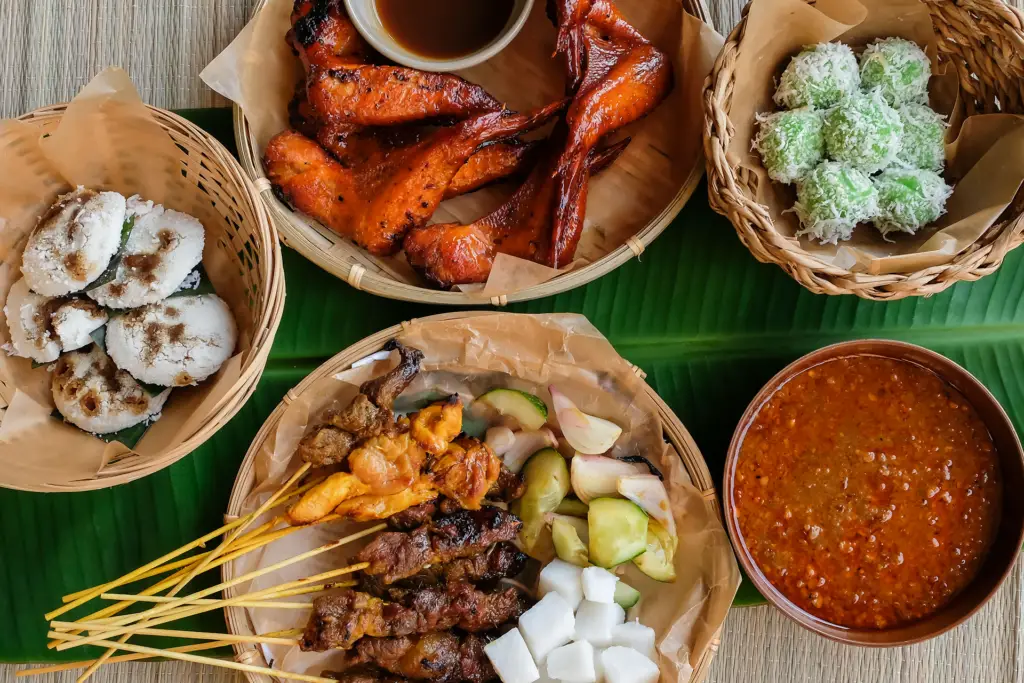
Malaysian cuisine is a vibrant and diverse culinary tapestry that reflects the country’s multicultural heritage, blending flavors from Malay, Chinese, Indian, and indigenous communities. Here are some traditional Malaysian dishes that showcase the rich tapestry of flavors:
Nasi Lemak
The “national dish” of Malaysia, Nasi Lemak translates to “coconut rice.” Fragrant rice cooked in coconut milk forms the base, topped with an array of delicious accompaniments like anchovies, peanuts, cucumber, egg, and sambal (chilli paste).
Each region adds its own twist, making it a true exploration of diverse flavors.
Satay
These succulent skewers of marinated meat (chicken, beef, or even seafood) are grilled to perfection, offering a smoky aroma and melt-in-your-mouth texture. Served with a peanut dipping sauce, cucumber, and onion, Satay is a popular street food and restaurant staple.
Laksa
This spicy noodle soup comes in countless variations depending on the region. Usually built around a coconut milk broth, it can be rich and creamy (Penang Laksa) or tangy and spicy (Curry Laksa).
Toppings like noodles, seafood, vegetables, and herbs create a complex and satisfying dish.
Rendang
A slow-cooked meat dish originating from Indonesia, Rendang has become a beloved part of Malaysian cuisine.
Meat (beef, chicken, or goat) is simmered for hours in a rich spice paste with coconut milk, resulting in tender meat infused with complex flavors and a melt-in-your-mouth texture.
Char Koay Teow
This stir-fried flat noodle dish is a Penang specialty, renowned for its smoky “wok hei” flavor. Flat rice noodles are stir-fried with eggs, bean sprouts, cockles, shrimp paste, and dark soy sauce, creating a flavorful and slightly chewy experience.
Popular Food in Malaysia
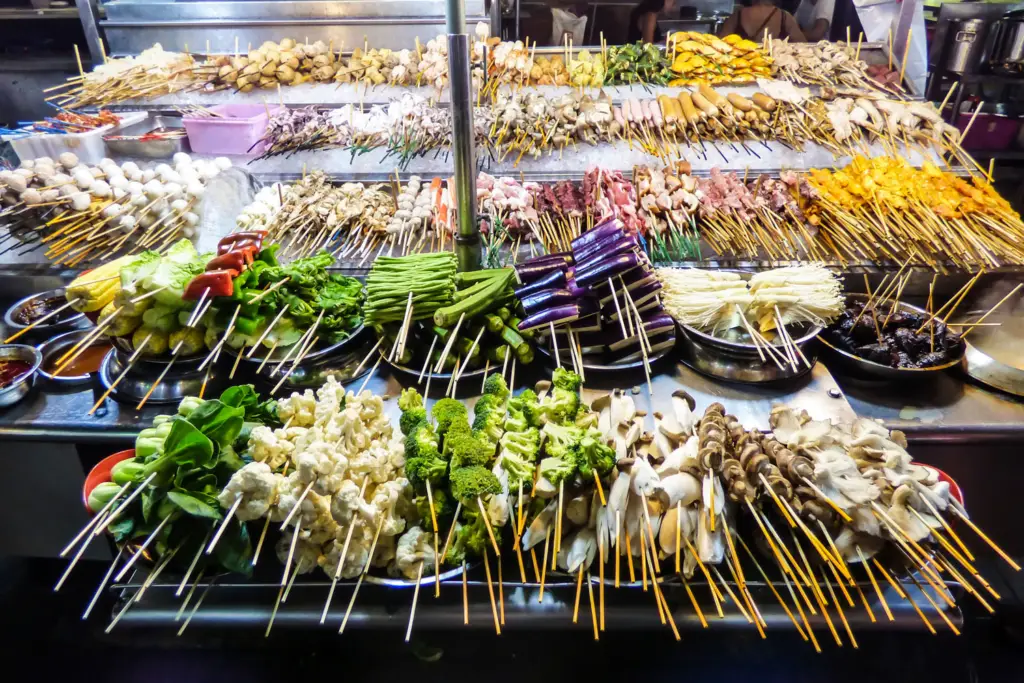
Here are 10 popular food dishes in Malaysia:
Nasi Lemak
A national favorite, Nasi Lemak is fragrant coconut rice served with anchovies, peanuts, boiled eggs, cucumber, and spicy sambal.
Satay
Grilled skewers of marinated meat, often chicken or beef, served with a tasty peanut sauce.
Char Kway Teow
Stir-fried flat rice noodles with prawns, Chinese sausage, bean sprouts, and chives, seasoned with soy sauce and chili paste.
Roti Canai
A popular breakfast choice, Roti Canai is a flaky, flatbread served with curry sauce or dhal (lentil curry).
Hainanese Chicken Rice
Poached chicken served with fragrant rice, accompanied by ginger paste, chili sauce, and a flavorful chicken broth.
Laksa
A spicy noodle soup with a coconut milk base, featuring ingredients like prawns, chicken, tofu puffs, and bean sprouts.
Nasi Goreng
Fried rice seasoned with a combination of sweet soy sauce, chili, garlic, tamarind, and various meats or seafood.
Rendang
A rich and flavorful dry curry made with beef or chicken, slow cooked with coconut milk and a blend of aromatic spices.
Kuih
A diverse range of bite-sized sweet and savory snacks, including colorful dumplings, cakes, and pastries.
Cendol
A refreshing dessert featuring green rice flour jelly noodles, coconut milk, shaved ice, and palm sugar syrup.
These dishes represent just a fraction of the culinary delights Malaysia has to offer, showcasing the country’s diverse cultural influences and rich flavors.
National Dish of Malaysia – Nasi Lemak
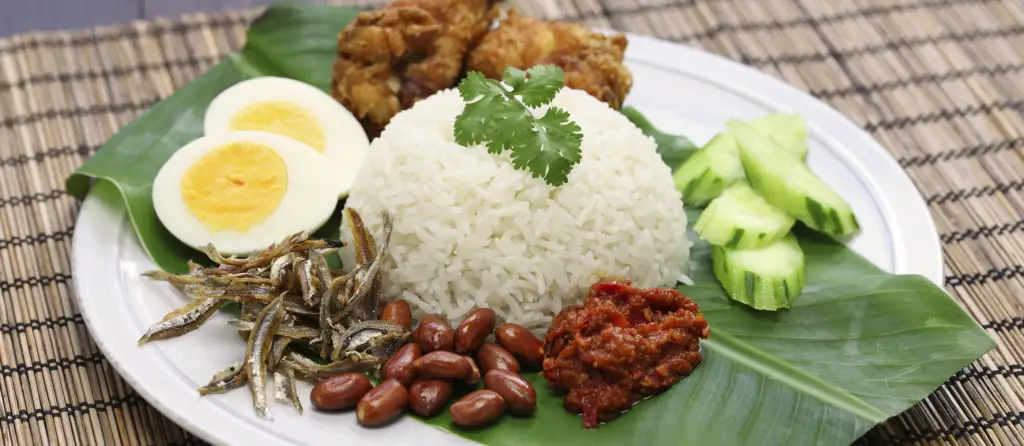
At the heart of Malaysian cuisine is the beloved ‘Nasi lemak’. A dish that’s as rich in flavor as it is in history. It consists of:
Malaysian cuisine Nasi Lemak Ingredients
- Rice
- Coconut milk
- Pandan leaves
- Ginger
- Salt
- Sambal (spicy chili paste)
- Anchovies
- Peanuts
- Hard-boiled eggs
- Cucumber
Nasi Lemak Preparation Method
- Rinse and soak rice. Cook it with coconut milk, pandan leaves, ginger, and salt until fluffy.
- Prepare sambal by grinding fresh chilies, shallots, and some dried shrimp. Sauté the mixture and add tamarind pulp and salt.
- Fry anchovies and peanuts until crispy.
- Serve rice with sambal, anchovies, peanuts, a slice of hard-boiled egg, and some cucumber slices.
Malaysian dishes you can Try at Home
While Malaysia’s landscapes and history play a significant role in shaping its cuisine, the true magic lies in the flavors and techniques that make every dish special.
And the good news? You don’t have to travel to Malaysia to experience its culinary delights! You can easily recreate any traditional Malaysian recipes in your own kitchen.
With a handful of authentic ingredients and a sprinkle of love, you can embark on a delightful gastronomic journey, right from the comfort of your home. Dive into the following recipes and let your taste buds explore Malaysian cuisine.
Malaysian Food – Asam Pedas Fish

Asam Pedas Fish: A Malaysian Tangy Delight
Hello, foodies! Today, we’re exploring the bold and tangy flavors of Malaysia with a classic dish known as Asam Pedas Fish. Originating from the southern regions of Malaysia, particularly Melaka, Asam Pedas Fish is a tantalizingly sour and spicy fish stew that has become a staple in Malaysian households.
Let’s embark on a journey to discover the vibrant history and prepare this mouthwatering recipe!
History and Background
Asam Pedas Fish traces its roots to the historical city of Melaka in Malaysia. With influences from Malay, Chinese, and Indian culinary traditions, this dish has evolved into a beloved Malaysian specialty.
The name “Asam Pedas” translates to “sour spicy,” capturing the essence of the bold and zesty flavors that define this dish.
Malaysian Food – Asam Pedas Fish Ingredients
- 500g fish fillets (snapper or mackerel)
- 2 tablespoons tamarind paste
- 1 stalk lemongrass, bruised
- 4 kaffir lime leaves
- 1 tomato, sliced
- 2 ladyfinger (okra), sliced
- 2 tablespoons vegetable oil
- 2 teaspoons palm sugar or brown sugar
- Salt to taste
Malaysian Food – Asam Pedas Fish Recipe
Preparing Ingredients:
- Soak Tamarind:
- Soak tamarind paste in 1 cup of warm water to extract the juice. Strain and set aside.
Cooking Steps:
- Sauté Aromatics:
- In a pot, heat vegetable oil. Add lemongrass, kaffir lime leaves, and sliced tomato. Sauté until fragrant.
- Add Tamarind Juice:
- Pour in the tamarind juice, bringing a burst of tangy flavor to the pot.
- Include Ladyfinger:
- Add sliced ladyfinger (okra) to the pot, allowing them to cook and absorb the flavors.
- Season with Sugar and Salt:
- Stir in palm sugar (or brown sugar) and salt, balancing the sweet and savory elements.
- Add Fish Fillets:
- Gently place fish fillets into the pot, ensuring they are submerged in the flavorful broth.
- Simmer to Perfection:
- Let the Asam Pedas simmer on low heat for 15-20 minutes, allowing the fish to cook through and absorb the delicious flavors.
- Serve Hot:
- Ladle the Asam Pedas Fish into bowls and serve hot with steamed rice.
Serving Information
- Servings: 4 people
- Cooking Time: Approximately 30 minutes
- Calories: Approximately 300 calories per serving
- Nutritional Information: Rich in protein, vitamins, and the goodness of tamarind. Asam Pedas Fish is a delightful Malaysian dish that packs a punch of flavors in every bite. Enjoy this tangy sensation straight from the heart of Malaysia!
Malaysian Food – Banana Leaf Meal

Banana Leaf Meal: A Malaysian Feast on a Leaf
Greetings, food enthusiasts! Today, we’re diving into the heart of Malaysian culinary traditions with a delightful experience known as the Banana Leaf Meal.
Hailing from the vibrant streets of South India and seamlessly embraced by Malaysia, this unique dining experience brings people together to enjoy a variety of flavors and textures served on a banana leaf. Let’s explore the history and create our own Banana Leaf Meal adventure!
History and Background
The Banana Leaf Meal has its roots in South Indian culture, where people traditionally consumed meals on banana leaves for their eco-friendly and aromatic qualities.
In Malaysia, this dining style has become a social and gastronomic event, showcasing a fusion of Indian, Malay, and Chinese flavors on a single leaf.
Malaysian Food – Banana Leaf Meal Ingredients
- Banana leaves (cleaned and prepared for serving)
- Steamed white rice
- Assorted curries (chicken, fish, or vegetable)
- Fried items (fish, chicken, or tofu)
- Dhal (lentil curry)
- Pickles (mango, lime, or mixed vegetables)
- Papadum (crispy lentil flatbread)
- Rasam (spicy tamarind soup)
- Sambar (spicy lentil and vegetable stew)
- Yogurt (optional)
- Sweets (optional)
Malaysian Food – Banana Leaf Meal Recipe
Preparing Ingredients:
- Clean Banana Leaves:
- Wash banana leaves thoroughly and wipe them clean. Cut them into individual serving-sized pieces.
Assembling the Banana Leaf Meal:
- Place Banana Leaf:
- Lay a banana leaf on a clean table or plate, shiny side up.
- Add Steamed Rice:
- Place a generous serving of steamed white rice in the center of the banana leaf.
- Arrange Assorted Curries:
- Surround the rice with various curries – chicken, fish, or vegetable.
- Include Fried Items:
- Add fried items like fish, chicken, or tofu to the ensemble.
- Serve Dhal and Pickles:
- Spoon dhal (lentil curry) onto the leaf and place pickles (mango, lime, or mixed vegetables) on the side.
- Add Papadum and Rasam:
- Include papadum for crunch and serve rasam (spicy tamarind soup) in a small bowl.
- Serve Sambar and Yogurt:
- Add sambar (spicy lentil and vegetable stew) to the array. Optionally, include a small portion of yogurt.
- Enjoy with Sweets (Optional):
- Complete the meal with a sweet treat, if desired.
Serving Information
- Servings: 1 person (adjust quantities for more)
- Preparation Time: Approximately 30 minutes (may vary based on the number of dishes)
- Calories: Varies based on individual choices, typically ranging from 600 to 1000 calories per serving.
- Nutritional Information: A balanced and diverse meal offering a mix of proteins, carbohydrates, and essential nutrients. The Banana Leaf Meal is not just a feast for the palate but also a cultural and communal experience. Enjoy the symphony of flavors on a single leaf!
Malaysian Food – Ayam Percik

Ayam Percik: Grilled Malaysian Chicken Perfection
Hello, foodies! Today, we’re embarking on a flavor-packed journey to Malaysia with the scrumptious Ayam Percik. Hailing from the vibrant streets of Kelantan, this dish is a grilled chicken delight bathed in a luscious coconut-based marinade.
Join me in exploring the history, savoring the cultural richness, and crafting your own Ayam Percik masterpiece!
History and Background
Ayam Percik traces its roots to Kelantan, a state in northeastern Malaysia. This culinary gem showcases the influence of Malay flavors, with a unique twist of local spices and coconut-infused goodness.
Traditionally enjoyed during festive occasions, Ayam Percik has become a beloved dish, celebrated for its rich taste and cultural significance.
Malaysian Food – Ayam Percik Ingredients
- 1 whole chicken, cleaned and cut into parts
- 1 cup coconut milk
- 3 tablespoons tamarind paste
- 2 lemongrass stalks, bruised
- 4 kaffir lime leaves
- 1 turmeric root, grated
- 4 shallots, finely chopped
- 3 cloves garlic, minced
- 2 tablespoons chili paste
- 2 tablespoons palm sugar or brown sugar
- Salt to taste
- Bamboo skewers (for grilling)
Malaysian Food – Ayam Percik Recipe
Preparing Ingredients:
- Prepare Chicken:
- Clean and cut the whole chicken into parts for even cooking.
- Soak Tamarind:
- Soak tamarind paste in warm water, then strain to extract the juice.
Marinating the Chicken:
- Create Marinade:
- In a bowl, mix coconut milk, tamarind juice, grated turmeric, chopped shallots, minced garlic, chili paste, palm sugar, and salt.
- Marinate the Chicken:
- Coat the chicken parts thoroughly with the marinade, ensuring every piece is well-covered. Let it marinate for at least 2 hours or overnight for enhanced flavor.
Grilling the Ayam Percik:
- Skewer Chicken Parts:
- Thread marinated chicken parts onto bamboo skewers, ready for grilling.
- Preheat Grill:
- Preheat your grill to medium-high heat.
- Grill to Perfection:
- Grill the Ayam Percik skewers, turning occasionally and basting with the remaining marinade until the chicken is cooked through and beautifully charred (approximately 20-25 minutes).
Serve and Enjoy:
- Garnish and Serve:
- Garnish with kaffir lime leaves and serve the Ayam Percik hot off the grill.
Serving Information
- Servings: 4 people
- Cooking Time: Approximately 30 minutes (plus marination time)
- Calories: Approximately 350 calories per serving
- Nutritional Information: Ayam Percik offers a balanced mix of proteins and coconut goodness. It’s a delightful dish that brings the flavors of Malaysia to your home. Gather your loved ones and savor the deliciousness of Ayam Percik!
Malaysian Food – Kenduri

Kenduri: A Malaysian Feast of Celebration
Hey there, fellow food lovers! Today, let’s dive into the heart of Malaysian festivities with the mouthwatering Kenduri. Originating from the diverse culinary landscape of Malaysia, Kenduri is a communal feast that brings people together to celebrate special occasions.
Join me as we unravel the history, flavors, and the joyous spirit behind this traditional Malaysian feast!
History and Background
Kenduri, deeply rooted in Malay culture, is a celebration of community and togetherness. It is often associated with significant life events such as weddings, birthdays, and religious ceremonies.
The term “kenduri” itself embodies the spirit of sharing and abundance, making it a cherished tradition in Malaysia.
Ingredients
- Steamed white rice
- Ayam Percik (Grilled Coconut Chicken)
- Beef Rendang (Spicy Coconut Beef)
- Udang Lemak Nenas (Pineapple Prawn Curry)
- Sayur Lodeh (Vegetable in Coconut Broth)
- Acar (Pickled Vegetables)
- Serunding (Spiced Grated Coconut)
- Nasi Impit (Compressed Rice)
- Sambal Belacan (Chili Shrimp Paste)
- Kuih (Assorted Traditional Malaysian Desserts)
Recipe
Preparing the Staples:
- Cook White Rice:
- Prepare steamed white rice as the staple for the Kenduri.
- Grill Ayam Percik:
- Follow the Ayam Percik recipe (see previous) to create flavorful grilled coconut chicken.
- Make Beef Rendang:
- Cook beef rendang by slow-cooking beef in a spicy coconut-based sauce until tender.
- Prepare Udang Lemak Nenas:
- Create Udang Lemak Nenas by cooking prawns in a rich pineapple-infused curry.
Complementary Dishes:
- Cook Sayur Lodeh:
- Make Sayur Lodeh by simmering assorted vegetables in a coconut broth.
- Prepare Acar:
- Prepare Acar by pickling a mix of vegetables for a tangy side.
- Make Serunding:
- Cook Serunding by spicing and grating coconut into a delicious, savory topping.
- Prepare Nasi Impit:
- Compress rice into Nasi Impit squares, a traditional rice cake.
- Prepare Sambal Belacan:
- Create Sambal Belacan by blending chili and shrimp paste for a spicy condiment.
Assorted Desserts:
- Prepare Kuih:
- Make a variety of Kuih, traditional Malaysian desserts, to sweeten the Kenduri experience.
Serving Information
- Servings: Suitable for a large gathering (adjust quantities based on the number of guests)
- Cooking Time: Approximately 3-4 hours
- Calories: Varies based on portions and dishes, ranging from 800 to 1200 calories per serving
- Nutritional Information: Kenduri offers a balanced mix of proteins, carbohydrates, and essential nutrients. This communal feast is not just a meal but a celebration of Malaysian flavors and traditions. Gather your loved ones, and let the Kenduri festivities begin!
Malaysian Food – Hakka Mee

Hakka Mee: A Malaysian Noodle Delight
Greetings, food enthusiasts! Today, we’re delving into the heart of Malaysia’s culinary tapestry with the delectable Hakka Mee. Originating from the Hakka Chinese community, this noodle dish has become a beloved part of Malaysia’s diverse food scene. Join me in uncovering the history, savoring the flavors, and crafting your own bowl of Hakka Mee perfection!
History and Background
Hakka Mee has its roots in the Hakka Chinese community, known for their unique culinary traditions. Over time, this dish has evolved in Malaysia, blending traditional Hakka flavors with local influences. The dish typically consists of egg noodles served in a savory soy-based broth, showcasing the multicultural essence of Malaysian cuisine.
Malaysian Food – Hakka Mee Ingredients
- 300g egg noodles
- 200g minced pork
- 2 cups choy sum (Chinese mustard greens), chopped
- 4 cloves garlic, minced
- 2 tablespoons vegetable oil
- 3 tablespoons soy sauce
- 2 tablespoons oyster sauce
- 1 tablespoon dark soy sauce
- 1 teaspoon sugar
- Salt and white pepper to taste
- Optional toppings: crispy shallots, chopped spring onions
Malaysian Food – Hakka Mee Recipe
Preparing Ingredients:
- Cook Egg Noodles:
- Cook the egg noodles according to package instructions. Drain and set aside.
- Prepare Choy Sum:
- Blanch the chopped choy sum in boiling water for 1-2 minutes. Drain and set aside.
Cooking Steps:
- Sauté Minced Pork:
- In a pan, heat vegetable oil. Sauté minced garlic until fragrant, then add minced pork. Cook until the pork is browned.
- Season Pork:
- Add soy sauce, oyster sauce, dark soy sauce, sugar, salt, and white pepper to the pork. Mix well and let it simmer for 2-3 minutes.
- Assemble Noodle Bowls:
- Divide the cooked egg noodles into serving bowls. Top with sautéed minced pork and blanched choy sum.
- Optional Toppings:
- Garnish with crispy shallots and chopped spring onions for added flavor and texture.
- Serve Hot:
- Pour hot broth or water over the noodle bowls to create a savory broth. Serve immediately.
Serving Information
- Servings: 2 people
- Cooking Time: Approximately 20 minutes
- Calories: Approximately 400 calories per serving
- Nutritional Information: Hakka Mee is a balanced dish with proteins from minced pork, greens for vitamins, and carbohydrates from egg noodles. Customize with your favorite toppings and enjoy this comforting bowl of Malaysian goodness!
Malaysian Food – Satay

Satay: Malaysian Grilled Skewers of Delight
Hey, food enthusiasts! Today, we’re venturing into the vibrant streets of Malaysia with the iconic Satay. Originating from Malay cuisine, Satay has become a beloved street food, gracing gatherings and celebrations with its tantalizing flavors.
Join me in exploring the history, savoring the unique blend of spices, and mastering the art of crafting these grilled skewers at home!
History and Background
Satay has deep roots in Malay culture and is a popular dish across Southeast Asia. The word “satay” itself is believed to have originated from the Indonesian-Malay word “sate” or “satai,” and it has a rich history dating back centuries.
Traditionally, Satay is made by marinating skewered and grilled meat in a flavorful blend of spices and served with a delectable peanut sauce.
Malaysian Food – Satay Ingredients
Satay Marinade:
- 500g chicken, beef, or lamb, cut into bite-sized pieces
- 2 tablespoons soy sauce
- 2 tablespoons honey or brown sugar
- 1 tablespoon vegetable oil
- 1 teaspoon turmeric powder
- 1 teaspoon coriander powder
- 1 teaspoon cumin powder
- 2 cloves garlic, minced
- 1 lemongrass stalk, finely chopped
- Wooden skewers, soaked in water
Peanut Sauce:
- 1 cup roasted peanuts, finely ground
- 2 tablespoons soy sauce
- 1 tablespoon tamarind paste
- 1 tablespoon brown sugar
- 1 teaspoon chili powder
- 1 clove garlic, minced
- 1 cup coconut milk
- 1 tablespoon vegetable oil
Malaysian Food – Satay Recipe
Preparing Satay Marinade:
- Prepare Meat:
- Cut chicken, beef, or lamb into bite-sized pieces.
- Create Marinade:
- In a bowl, combine soy sauce, honey or brown sugar, vegetable oil, turmeric powder, coriander powder, cumin powder, minced garlic, and chopped lemongrass.
- Marinate Meat:
- Coat the meat pieces with the marinade and let them marinate for at least 2 hours, or preferably overnight, for maximum flavor.
Making Peanut Sauce:
- Prepare Peanuts:
- Finely ground the roasted peanuts using a food processor.
- Create Sauce Base:
- In a pan, heat vegetable oil. Add minced garlic, soy sauce, tamarind paste, brown sugar, and chili powder. Stir until fragrant.
- Add Coconut Milk:
- Pour in coconut milk and bring the mixture to a gentle simmer.
- Combine with Peanuts:
- Gradually add the ground peanuts, stirring continuously until the sauce thickens. Adjust the consistency with water if needed.
Grilling Satay:
- Skewer Meat:
- Thread the marinated meat onto soaked wooden skewers.
- Grill Satay:
- Grill the skewers on a barbecue or grill pan until the meat is cooked through and has a beautiful char (approximately 10-15 minutes).
Serving Information
- Servings: 4 people
- Cooking Time: Approximately 30 minutes (plus marination time)
- Calories: Approximately 300 calories per serving
- Nutritional Information: Satay offers a protein-packed delight with a burst of flavorful spices. Serve these grilled skewers with peanut sauce for an authentic Malaysian experience!
Malaysian Food – Roti Cana

Roti Canai: Flaky Layers of Malaysian Delight
Greetings, food aficionados! Today, we’re embarking on a culinary journey to explore the delectable Roti Canai. Originating from the Indian-Muslim community in Malaysia, this flaky, layered flatbread has become a beloved staple. Join me in uncovering the history, savoring the cultural blend, and learning to recreate the magic of Roti Canai right in your own kitchen!
History and Background
Roti Canai has its roots in Indian cuisine, brought to Malaysia by Indian-Muslim traders. The word “roti” means bread, and “canai” is derived from the Tamil word “canaiy,” which means flat. This dish has evolved over time, becoming an integral part of Malaysia’s diverse food landscape. Served with various accompaniments, Roti Canai reflects the multicultural essence of the country.
Malaysian Food – Roti Cana Ingredients
Roti Canai Dough:
- 4 cups all-purpose flour
- 1 tablespoon condensed milk
- 1 teaspoon sugar
- 1 teaspoon salt
- 1 egg
- 1 cup water, approximately (for kneading)
- 1 cup ghee or clarified butter (for cooking)
Accompaniments:
- Chicken curry
- Dhal (lentil curry)
- Sambal (spicy chili paste)
Malaysian Food – Roti Cana Recipe
Preparing Roti Canai Dough:
- Combine Dry Ingredients:
- In a large bowl, mix the all-purpose flour, sugar, and salt.
- Add Wet Ingredients:
- Add the condensed milk, egg, and gradually add water while kneading the dough. Knead until it becomes soft and pliable.
- Let the Dough Rest:
- Coat the dough with a bit of oil, cover it, and let it rest for at least 4 hours or overnight.
Making Roti Canai:
- Divide and Shape Dough:
- Divide the rested dough into golf ball-sized portions. Roll each portion into a smooth ball.
- Stretching the Dough:
- Using ghee or clarified butter, grease your hands and the work surface. Flatten a dough ball and stretch it until it becomes thin and translucent. Fold it into a square or round shape.
- Cooking Roti Canai:
- Heat a flat pan or griddle. Place the stretched dough on it and cook until both sides are golden brown, brushing with ghee as needed.
- Serve Hot:
- Serve Roti Canai hot off the griddle with chicken curry, dhal, and sambal.
Serving Information
- Servings: 6 people
- Cooking Time: Approximately 30 minutes (plus resting time for the dough)
- Calories: Approximately 200 calories per piece of Roti Canai (without accompaniments)
- Nutritional Information: Roti Canai is a delightful treat that can be enjoyed with various accompaniments. This flaky flatbread offers a blend of textures and flavors, making it a favorite across Malaysia. Gather your loved ones and experience the joy of making and savoring Roti Canai at home!
Malaysian Food – Hainanese Chicken Rice

Hainanese Chicken Rice: A Malaysian Comfort Classic
Hello, food enthusiasts! Today, we’re diving into the heart of Malaysian comfort food with the beloved Hainanese Chicken Rice. Originating from the Hainan province in China, this dish has evolved into a Malaysian staple, cherished for its tender poached chicken, fragrant rice, and aromatic sauces.
Join me on this culinary journey as we explore the history, savor the regional influence, and learn to craft this delightful dish at home.
History and Background
Hainanese Chicken Rice traveled from its roots in Hainan, China, to become a culinary gem in Malaysia. The dish is a perfect example of cultural fusion, as Hainanese immigrants brought their traditional cooking techniques to Malaysia, adapting to local flavors and creating a unique and beloved dish.
Malaysian Food – Hainanese Chicken Rice Ingredients
Poached Chicken:
- 1 whole chicken (approximately 3-4 pounds)
- 2 slices ginger
- 2 stalks spring onions
- Salt, to taste
- Ice water (for an ice bath)
Fragrant Rice:
- 2 cups jasmine rice
- 3 cups chicken broth (from poached chicken)
- 2 slices ginger
- 1 pandan leaf (optional)
- Salt, to taste
Dipping Sauce:
- Soy sauce
- Sesame oil
- Ginger, minced
- Garlic, minced
- Bird’s eye chili, chopped (optional)
Malaysian Food – Hainanese Chicken Rice Recipe
Preparing Poached Chicken:
- Clean the Chicken:
- Rinse the chicken thoroughly, inside and out.
- Poaching Chicken:
- In a large pot, bring water to a boil. Add ginger, spring onions, and a pinch of salt. Place the whole chicken in the pot, reduce heat, and simmer until the chicken is cooked through.
- Ice Bath:
- Remove the chicken and immediately submerge it in an ice bath to stop the cooking process. This helps keep the chicken skin tender.
Making Fragrant Rice:
- Rinsing Rice:
- Rinse jasmine rice until the water runs clear.
- Cooking Rice:
- In a rice cooker or pot, sauté ginger with a bit of oil. Add rinsed rice and stir for a minute. Pour in chicken broth, add pandan leaf (if using), and season with salt. Cook until the rice is done.
Preparing Dipping Sauce:
- Mixing Sauce:
- In a small bowl, mix soy sauce, sesame oil, minced ginger, minced garlic, and chopped bird’s eye chili (if using). Adjust the ratios according to your taste preferences.
Serving:
- Slice Chicken:
- Once the chicken has cooled, slice it into bite-sized pieces.
- Plating:
- Serve the sliced chicken on a plate with a side of fragrant rice. Drizzle the dipping sauce over the chicken or serve it on the side.
Serving Information
- Servings: 4 people
- Cooking Time: Approximately 1 hour
- Calories: Approximately 400 calories per serving (without dipping sauce)
- Nutritional Information: Hainanese Chicken Rice is a balanced meal, offering lean protein from the chicken and carbohydrates from the fragrant rice. Customize your dipping sauce, and savor this Malaysian comfort classic with family and friends!
Malaysian Food – Nasi Goreng

Nasi Goreng: The Flavorful Essence of Malaysian Fried Rice
Hello, foodies! Today, we’re delving into the enticing world of Malaysian cuisine with the iconic Nasi Goreng. Originating from the vibrant streets of Indonesia and adopted with flair in Malaysia, Nasi Goreng is a beloved fried rice dish, teeming with aromatic spices and a fusion of flavors.
Join me as we explore the history, celebrate the regional influence, and master the art of creating this delightful dish in your own kitchen.
History and Background
Nasi Goreng, which translates to “fried rice” in Malay, holds roots in Indonesian culture. As Malaysia shares cultural ties with Indonesia, this dish has become a cherished part of Malaysian culinary heritage.
It’s a versatile and customizable dish, reflecting the diverse influences that make Malaysian cuisine so unique.
Malaysian Food – Nasi Goreng Ingredients
For Nasi Goreng:
- 2 cups cooked jasmine rice (preferably day-old)
- 200g chicken breast, diced
- 100g prawns, peeled and deveined
- 2 eggs, beaten
- 1 cup mixed vegetables (carrots, peas, corn)
- 4 shallots, thinly sliced
- 3 cloves garlic, minced
- 2 tablespoons soy sauce
- 1 tablespoon oyster sauce
- 1 tablespoon kecap manis (sweet soy sauce)
- 1 teaspoon chili paste (sambal oelek)
- 1 teaspoon shrimp paste (optional)
- Cooking oil
- Salt and pepper to taste
Malaysian Food – Nasi Goreng Recipe
Preparing Ingredients:
- Cooking Rice:
- Use day-old jasmine rice for the best texture.
- Prepping Proteins:
- Dice chicken breast, peel and devein prawns, and beat the eggs.
Making Nasi Goreng:
- Stir-Frying Aromatics:
- Heat oil in a wok. Sauté sliced shallots and minced garlic until fragrant.
- Adding Proteins:
- Add diced chicken and cook until it’s no longer pink. Add prawns and stir-fry until they turn pink.
- Vegetables and Eggs:
- Toss in mixed vegetables and cook until slightly tender. Push the ingredients to one side of the wok and pour beaten eggs into the empty side. Scramble the eggs until cooked.
- Incorporating Rice:
- Add the day-old jasmine rice to the wok, breaking up any clumps. Mix everything together.
- Flavorful Sauces:
- Pour in soy sauce, oyster sauce, kecap manis, chili paste (sambal oelek), and shrimp paste (if using). Stir to combine.
- Seasoning:
- Season with salt and pepper to taste. Continue to stir-fry until everything is well-incorporated.
Serving Information
- Servings: 4 people
- Cooking Time: Approximately 20 minutes
- Calories: Approximately 400 calories per serving
- Nutritional Information: Nasi Goreng is a wholesome meal, providing a mix of protein, carbohydrates, and vegetables. Serve this delightful Malaysian fried rice with a side of cucumber slices and a fried egg on top. Gather your loved ones and experience the joy of savoring Nasi Goreng together!
Malaysian Food – Mushroom Korma

Mushroom Korma: A Malaysian Twist to Indian Comfort
Greetings, food enthusiasts! Today, we’re venturing into the heart of Malaysian-Indian cuisine with the scrumptious Mushroom Korma. Malaysian food culture is a colorful blend, and this dish perfectly reflects the diverse culinary tapestry.
Originating from the Indian community in Malaysia, Mushroom Korma has become a beloved comfort food, celebrated for its aromatic spices and rich, creamy texture. Join me as we explore the history, embrace the cultural background, and learn how to create this delightful dish in your own kitchen.
History and Background
Mushroom Korma has its roots in the rich tapestry of Indian flavors that found a home in Malaysia. The dish is a wonderful fusion, blending traditional Indian spices with the diverse Malaysian culinary landscape.
Malaysian/Indian cuisine, with its vibrant mix of flavors, has become an integral part of the country’s food scene.
Malaysian Food – Mushroom Korma Ingredients
Mushroom Korma
- 2 cups button mushrooms, sliced
- 1 large onion, finely chopped
- 2 tomatoes, pureed
- 1/2 cup yogurt
- 1/4 cup cashews, soaked in water
- 2 tablespoons vegetable oil
- 1 teaspoon ginger-garlic paste
- 1 teaspoon cumin powder
- 1 teaspoon coriander powder
- 1/2 teaspoon turmeric powder
- 1/2 teaspoon red chili powder
- 1/2 teaspoon garam masala
- Salt to taste
- Fresh coriander leaves for garnish
Recipe
Preparing Mushroom Korma
- Soaking Cashews:
- Soak cashews in water for 15-20 minutes. Drain and set aside.
- Sauteing Onions:
- In a pan, heat vegetable oil. Add finely chopped onions and sauté until golden brown.
- Adding Ginger-Garlic Paste:
- Stir in ginger-garlic paste and cook for another minute until the raw aroma disappears.
- Spice Infusion:
- Add cumin powder, coriander powder, turmeric powder, and red chili powder. Mix well.
- Tomato Puree:
- Pour in the pureed tomatoes and cook until the oil starts to separate from the masala.
- Cooking Mushrooms:
- Add sliced mushrooms and cook until they release their moisture and become tender.
- Blending Cashews:
- In a blender, blend soaked cashews with yogurt until smooth. Pour this mixture into the pan and stir.
- Simmering and Seasoning:
- Let the Korma simmer on low heat. Season with salt and sprinkle garam masala. Allow the flavors to meld.
- Garnishing and Serving:
- Garnish with fresh coriander leaves. Serve Mushroom Korma hot with rice or naan.
Serving Information
- Servings: 4 people
- Cooking Time: Approximately 30 minutes
- Calories: Approximately 220 calories per serving
- Nutritional Information: Mushroom Korma offers a delightful mix of proteins, vitamins, and essential nutrients. Enjoy the comforting warmth of this Malaysian-Indian fusion dish with family and friends. It’s a delightful journey for your taste buds!
Malaysian Food – Nasi Dagang

A Malaysian Coastal Culinary Treasure
Hey, foodies! Today, we’re venturing into the coastal regions of Malaysia to explore the flavors of Nasi Dagang.
Originating from the northeastern states, this dish is a culinary gem that marries the influences of Malaysia’s vibrant food culture. Join me as we uncover the history, celebrate the coastal background, and embark on a delicious journey to recreate Nasi Dagang in your own kitchen.
History and Background
Nasi Dagang, which translates to “trading rice,” has its roots in the states of Terengganu and Kelantan. Historically, it was a dish prepared by fishermen for their journeys to trade.
Over time, Nasi Dagang evolved into a beloved Malaysian dish, celebrated for its unique blend of flavors and the ingenious use of local ingredients.
Malaysian Food – Nasi Dagang Ingredients
Nasi Dagang Rice:
- 2 cups glutinous rice
- 1 cup jasmine rice
- 1 cup coconut milk
- 2 cups water
- 1 teaspoon salt
Fish Curry:
- 500g mackerel or tuna, cut into chunks
- 1 can coconut milk
- 2 tablespoons fish curry powder
- 2 stalks lemongrass, bruised
- 4 kaffir lime leaves
- 2 tablespoons tamarind paste
- 4 shallots, minced
- 3 cloves garlic, minced
- 2 tablespoons cooking oil
- Salt and sugar to taste
Sambal (Chili Paste):
- 10 dried red chilies, soaked
- 4 shallots
- 2 cloves garlic
- 1 teaspoon tamarind paste
- 1 tablespoon palm sugar
- Salt to taste
Malaysian Food – Nasi Dagang Recipe
Preparing Nasi Dagang Rice:
- Rinsing and Soaking Rice:
- Rinse glutinous rice and jasmine rice until the water runs clear. Soak them together for at least 4 hours or overnight.
- Cooking Rice:
- Drain the soaked rice. In a pot, combine rice, coconut milk, water, and salt. Cook until the rice is tender and has absorbed the liquid.
Making Fish Curry:
- Sautéing Aromatics:
- In a pan, sauté minced shallots and garlic in cooking oil until fragrant.
- Adding Curry Powder:
- Add fish curry powder and continue to sauté for a minute.
- Cooking Fish:
- Add coconut milk, lemongrass, kaffir lime leaves, tamarind paste, and chunks of fish. Simmer until the fish is cooked through. Season with salt and sugar.
Preparing Sambal:
- Blending Ingredients:
- Blend soaked dried red chilies, shallots, garlic, tamarind paste, palm sugar, and salt until smooth.
Serving Information
- Servings: 4 people
- Cooking Time: Approximately 1 hour (including soaking time)
- Calories: Approximately 500 calories per serving
- Nutritional Information: Nasi Dagang offers a perfect balance of proteins, carbohydrates, and rich flavors. Serve the rice with the fragrant fish curry and spicy sambal for an authentic Malaysian experience. Gather your family and friends, and enjoy the coastal delight of Nasi Dagang!
Malaysian Food – Kuih

Malaysian Sweet Treats with a Rich Culinary Heritage
Hello, fellow food enthusiasts! Today, we’re diving into the world of Malaysian sweets with the delightful Kuih. Originating from the diverse tapestry of Malaysian culture, Kuih encompasses a variety of bite-sized, sweet snacks that have become an integral part of Malaysian culinary traditions.
Join me as we explore the history, celebrate the cultural background, and learn how to create these mouthwatering delights in the comfort of your own kitchen.
History and Background
Kuih, a term that broadly refers to traditional Malaysian sweet snacks, has its roots deeply embedded in the country’s rich cultural tapestry. These treats have been passed down through generations, with each region and community adding its unique twist.
From street vendors to family gatherings, Kuih is a cherished part of Malaysian celebrations and everyday life.
Malaysian Food – Kuih Ingredients
Lapis (Layered Cake)
- cup rice flour
- 1 cup coconut milk
- 1 cup water
- 1/2 cup sugar
- A pinch of salt
- Food coloring (optional)
Bingka Ubi (Tapioca Cake)
- 2 cups grated tapioca
- 1 cup coconut milk
- 1 cup sugar
- 2 eggs
- A pinch of salt
- Butter for greasing
Keria (Sweet Potato Donuts)
- 2 cups mashed sweet potatoes
- 1 cup self-rising flour
- 1/4 cup sugar
- A pinch of salt
- Cooking oil for frying
Malaysian Food – Kuih Recipe
Making Kuih Lapis:
- Mixing Batter:
- In a bowl, whisk together rice flour, coconut milk, water, sugar, and a pinch of salt until smooth.
- Layering Colors:
- Divide the batter into equal portions. Add food coloring to each portion for a vibrant, layered effect.
- Steaming Layers:
- Pour a layer of one colored batter into a greased pan and steam until set. Repeat with alternate colors until the batter is used up.
Preparing Kuih Bingka Ubi:
- Mixing Ingredients:
- Combine grated tapioca, coconut milk, sugar, eggs, and a pinch of salt. Mix until well combined.
- Baking Tapioca Cake:
- Pour the mixture into a greased pan and bake until the edges are golden brown and the center is set.
Making Kuih Keria:
- Mixing Sweet Potato Dough:
- In a bowl, combine mashed sweet potatoes, self-rising flour, sugar, and a pinch of salt. Mix until a soft dough forms.
- Shaping and Frying:
- Shape the dough into donuts and fry in hot oil until golden brown. Roll them in sugar while they’re still warm.
Serving Information
- Servings: Varies (depending on the quantity of each Kuih)
- Cooking Time: Approximately 1 hour (combined)
- Calories: Varies (approximately 100-150 calories per serving)
- Nutritional Information: Kuih offers a delightful array of flavors and textures. Whether you’re indulging in the layered goodness of Kuih Lapis, the chewy delight of Kuih Bingka Ubi, or the sweet potato goodness of Kuih Keria, these treats are sure to bring joy to your taste buds. Share them with friends and family, and savor the sweetness of Malaysian Kuih!
Malaysian Food – Mooncakes

A Celestial Treat from Malaysia’s Festive Tradition
Hello, foodies! Today, we’re delving into the world of Malaysian celebrations with the iconic Mooncakes. Originating from the heart of Chinese traditions, Mooncakes have become a symbol of unity and family during the Mid-Autumn Festival.
Join me as we explore the history, embrace the cultural background, and embark on the delightful journey of crafting Mooncakes in your own kitchen.
History and Background
Mooncakes hold a significant place in Chinese culture, especially during the Mid-Autumn Festival. This festival, celebrated on the 15th day of the eighth month in the lunar calendar, marks the harvest season and a time for families to come together.
Mooncakes, with their intricate designs and rich fillings, symbolize unity, completeness, and the beauty of the moon.
Malaysian Food – Mooncakes Ingredients
Mooncake Dough:
- 2 cups all-purpose flour
- 1/2 cup golden syrup
- 1/4 cup vegetable oil
- 1/4 teaspoon alkaline water (lye water)
Mooncake Filling:
- 1 cup red bean paste or lotus seed paste
- 1 salted egg yolk (cooked and halved)
Malaysian Food – Mooncakes Recipe
Making Mooncake Dough:
- Mixing Dry Ingredients:
- In a large bowl, combine all-purpose flour and make a well in the center.
- Adding Wet Ingredients:
- Pour in golden syrup, vegetable oil, and alkaline water. Mix until a soft dough forms.
- Resting the Dough:
- Cover the dough and let it rest for 30 minutes.
Preparing Mooncake Filling:
- Dividing and Shaping:
- Divide red bean paste or lotus seed paste into equal portions. Shape them into balls.
- Wrapping Filling:
- Flatten a portion of the dough, place a ball of filling in the center, and wrap the dough around it. Ensure the filling is completely enclosed.
- Molding Mooncakes:
- Press the filled dough into a mooncake mold to create intricate designs. Place the shaped mooncakes on a lined baking tray.
Baking Mooncakes:
- Adding Egg Yolk:
- Gently press a halved cooked salted egg yolk onto the center of each mooncake.
- Baking:
- Preheat the oven to 350°F (180°C). Bake the mooncakes for 20-25 minutes or until the crust turns golden brown.
- Cooling and Serving:
- Allow the mooncakes to cool before serving. They are traditionally enjoyed with a cup of tea during the Mid-Autumn Festival.
Serving Information
- Servings: 12 mooncakes
- Cooking Time: Approximately 1 hour (including resting and baking time)
- Calories: Approximately 180 calories per mooncake
- Nutritional Information: Mooncakes, while rich in flavor, are enjoyed in moderation. Share these delectable treats with your loved ones as you celebrate the joyous Mid-Autumn Festival together!
Malaysian Cuisine – Popiah
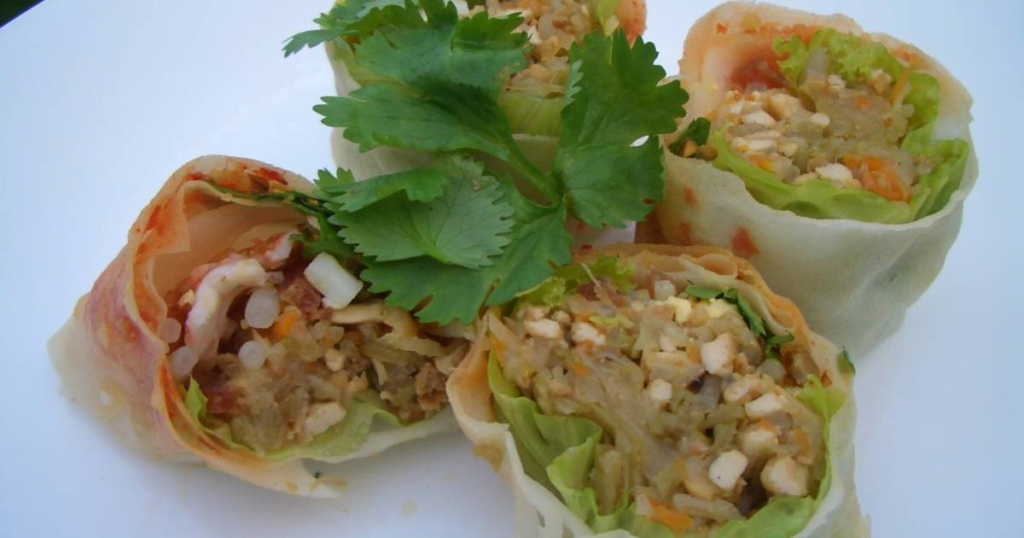
This is a popular Southeast Asian dish, often likened to a spring roll or fresh summer roll. In Malaysia, Popiah is typically served fresh, not deep-fried.
It’s a thin pancake or crepe rolled with a variety of fillings – usually a mixture of finely grated and steamed jicama (turnip), carrots, and other ingredients, making it both savory and slightly sweet.
Malaysian Cuisine – Popiah Ingredients
Popiah Skins:
- Ready-made Popiah skins are available at Asian grocery stores, but you can also make them from scratch using a mixture of flour, water, and salt.
Filling:
- Jicama (turnip): Peeled and finely grated.
- Carrot: Peeled and finely grated.
- Firm tofu (tau kwa): Thinly sliced and fried.
- Shrimp: Peeled, deveined, and chopped. You can also leave them whole.
- Garlic: Minced.
- Lettuce leaves: Washed and drained.
- Bean sprouts: Washed and drained.
- Fried shallots.
- Crushed peanuts.
- Chinese sausage (lap cheong): Thinly sliced and pan-fried (optional).
- Eggs: Make thin omelettes and then slice them finely.
- Salt, pepper, and sugar: For seasoning.
Sauces:
- Sweet sauce (tim cheong): A thick, sweet bean sauce or hoisin sauce.
- Chili sauce: To taste.
- Groundnut oil: Some versions include a bit of this oil, infused with garlic.
Malaysian Cuisine – Popiah Cooking Method
Preparing the Filling:
- Heat oil in a pan, sauté garlic until fragrant.
- Add in the shrimp and cook until they turn pink.
- Add the grated jicama and carrot to the pan. Season with salt, pepper, and a bit of sugar. Cook until they are soft and the mixture is fairly dry. This forms the primary filling.
Sauce Preparation:
- If you’re using groundnut oil infused with garlic: Heat some groundnut oil in a pan, fry some minced garlic until golden, then discard the garlic, keeping the oil.
- Mix the sweet sauce (tim cheong) and chili sauce, then combine with a bit of the garlic-infused oil to give an extra kick. This mixture is spread onto the Popiah skin before assembling.
Assembling the Popiah:
- Lay a Popiah skin on a flat surface.
- Spread a bit of the sauce mixture (from step 2) onto the skin.
- Place a lettuce leaf over the sauce, followed by a spoonful of the jicama-carrot filling.
- Add the other ingredients: tofu slices, bean sprouts, fried shallots, crushed peanuts, Chinese sausage (if using), egg slices, and additional sauce if desired.
- Fold in the sides of the Popiah skin and roll it tightly. Repeat with the remaining ingredients.
Serving:
- Slice the rolled Popiah into bite-sized portions (optional).
- Serve immediately with additional dipping sauce if desired.
Popiah is a versatile dish. You can modify the ingredients according to preference. Some variations also include crab meat, and there are even dessert versions with sweet fillings. Enjoy your culinary exploration of this delightful Malaysian snack!
Malaysian Cuisine – Kerabu Mangga (Mango Salad)

Kerabu Mangga, or Mango Salad, is a vibrant Malaysian dish that’s a delightful blend of sweet, sour, spicy, and savory flavors. The star ingredient, green mango, lends a tangy and slightly crunchy texture which contrasts beautifully with the other components.
Malaysian Cuisine – Kerabu Mangga Ingredients
Main Components:
- Green mangoes: 2 or 3, peeled and julienned or grated.
- Red onion or shallots: 1 or 2, thinly sliced.
- Red and green chilies: 2-3 each, deseeded and julienned.
- Dried shrimp: A handful, soaked in hot water for 10 minutes to soften, then drained and coarsely pounded.
- Roasted peanuts: Crushed, for garnish.
- Fresh coriander: Chopped, for garnish.
Dressing:
- Lime juice: From 1 or 2 limes.
- Fish sauce or belacan (fermented shrimp paste): To taste. If using belacan, you’d need to toast it slightly before using.
- Sugar: To taste.
- Garlic: 1 clove, minced (optional).
- Galangal: A small piece, minced (optional).
Malaysian Cuisine – Kerabu Mangga Cooking Method
Preparing the Dressing:
- In a bowl, combine lime juice, fish sauce or toasted belacan, sugar, minced garlic (if using), and minced galangal (if using).
- Stir well until the sugar is dissolved. Taste and adjust the seasoning to get the right balance of sweet, sour, and salty.
Assembling the Salad:
- In a large mixing bowl, combine the julienned green mangoes, sliced red onion or shallots, julienned chilies, and pounded dried shrimp.
- Pour the dressing over the ingredients and toss well, ensuring everything is well-coated.
Serving:
- Transfer the mixed salad to a serving dish.
- Garnish with crushed roasted peanuts and fresh coriander.
- Serve immediately to enjoy the freshness and crunch of the salad.
Malaysian Cuisine – Kerabu Mangga Tips
- The key to a good Kerabu Mangga is the balance of flavors. It should be a harmonious mix of tangy, spicy, sweet, and salty.
- You can adjust the level of spiciness according to your preference.
- Some versions also include bits of deep-fried crispy fish or squid as an additional component.
- Green mango refers to unripe mangoes. They should be firm and slightly sour, providing a nice contrast to the other flavors in the salad.
Enjoy your refreshing and tangy Kerabu Mangga as a delightful appetizer or side dish in a Malaysian meal!
Malaysian Cuisine – Rendang

Rendang is a rich and aromatic meat dish that originated from the Minangkabau ethnic group of Indonesia. It’s widely enjoyed in Malaysia, especially among the Malay community. The dish involves slow-cooking meat (commonly beef) in a mixture of coconut milk and a medley of herbs and spices until it becomes tender and flavorful.
Malaysian Cuisine – Rendang Ingredients
Main:
- Beef: 500g – 1kg, cut into large chunks. (Traditionally, beef is used, but chicken can also be an alternative.)
Spice Paste (to be blended):
- Shallots: 6-8, peeled.
- Garlic cloves: 3-4.
- Lemongrass: 2 stalks, white part only.
- Dried red chilies: 8-10, soaked in warm water to soften. (Adjust according to desired spiciness.)
- Ginger: 2 cm piece.
- Galangal (lengkuas): 2 cm piece.
- Turmeric (kunyit): 2 cm piece or 1 tsp of turmeric powder.
Additional Ingredients:
- Kerisik: Toasted coconut paste (can be made by dry frying grated coconut in a pan until golden brown and then pounding it into a paste).
- Coconut milk: 400ml from 1 coconut.
- Kaffir lime leaves: 4-5, torn.
- Turmeric leaf (daun kunyit): 1, torn (if available).
- Tamarind paste (asam jawa): 1 tablespoon, dissolved in a little water.
- Sugar: To taste.
- Salt: To taste.
Malaysian Cuisine – Rendang Cooking Method:
Preparing the Spice Paste:
- In a blender or food processor, blend all the ingredients for the spice paste with a little water until smooth.
Cooking the Rendang:
- In a large pot or pan, add a bit of oil and sauté the blended spice paste until aromatic and the oil begins to separate from the paste.
- Add the beef pieces and cook until they are browned.
- Pour in the coconut milk, and add the tamarind paste mixture. Stir well.
- Add the torn kaffir lime leaves and turmeric leaf (if using).
- Bring the mixture to a boil and then lower the heat to let it simmer.
- Add the Kerisik, stirring well to incorporate it into the sauce.
- Season with sugar and salt. Adjust according to taste.
- Continue to simmer on low heat, stirring occasionally, until the meat is tender and the gravy has thickened and is well-absorbed by the meat. This can take anywhere from 2 to 4 hours.
- The end result should be a dark brown and rich beef stew with a thick gravy.
- Serving:
- Serve the rendang hot with steamed rice, preferably jasmine or basmati.
Malaysian Cuisine – Rendang Cooking Tips
- Rendang is characterized by its thick gravy. It’s not meant to be a soupy dish.
- The longer you cook rendang, the better the flavors develop.
- Rendang is often made for special occasions and can be stored for a long duration due to its reduced moisture content.
- For a less intense version, you can cook it for a shorter time, which will give you a lighter-colored gravy.
Enjoy your hearty and flavorful Rendang, a classic dish that’s deeply loved in both Malaysian and Indonesian cuisines!
Malaysian Cuisine – Char Kway Teow
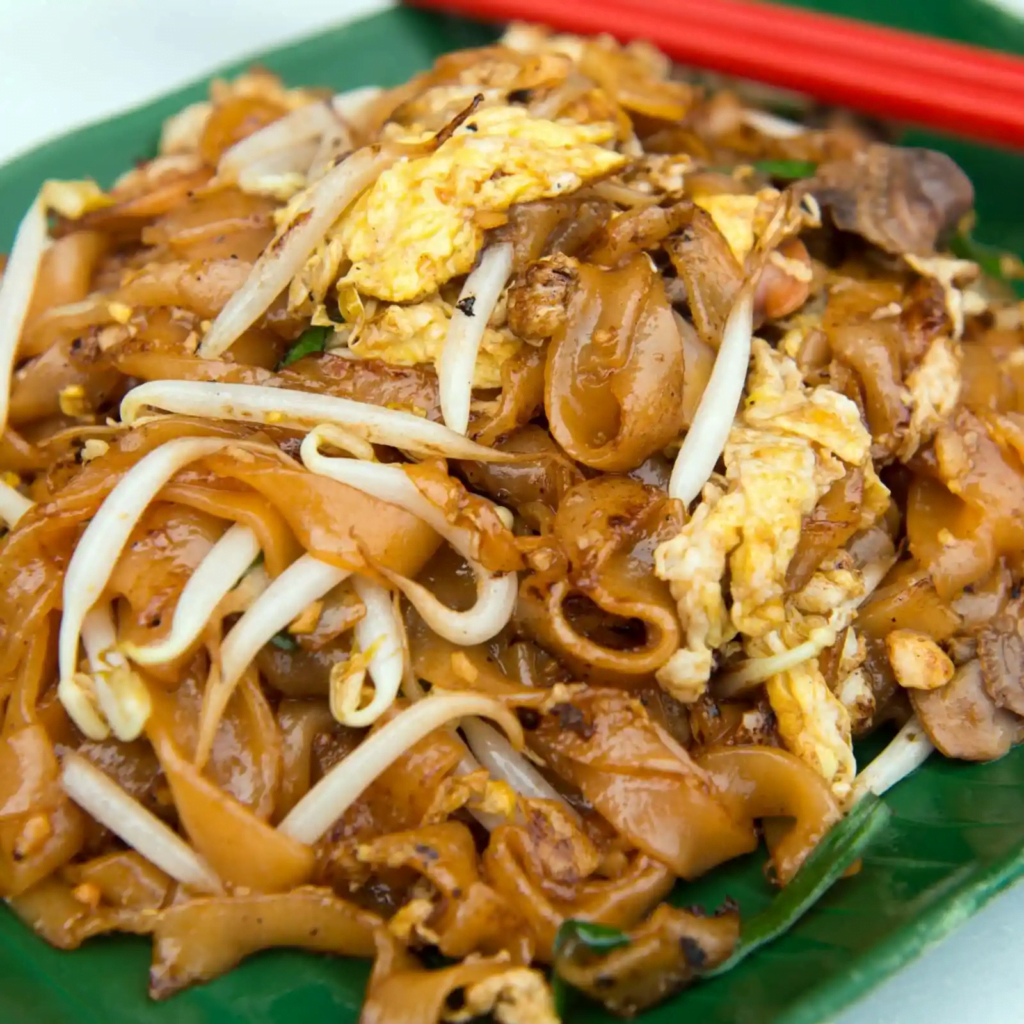
Char Kway Teow is a popular street food dish in Malaysia, particularly in Penang. It’s a stir-fried noodle dish that’s flavorful, with a mix of sweet, savory, and spicy notes. The dish uses flat rice noodles and is stir-fried with a variety of ingredients.
Malaysian Cuisine – Char Kway Teow Ingredients
Flat Rice Noodles (Kway Teow)
- Fresh is best, but dried ones can be used (ensure they are soaked and separated before cooking).
Proteins:
- Prawns (shrimp) – peeled and deveined.
- Blood cockles (optional) – cleaned and shelled.
- Chinese sausage (Lap Cheong) – thinly sliced.
- Fish cake – sliced.
- Egg.
Vegetables:
- Bean sprouts – cleaned and ends removed.
- Chinese chives (garlic chives) – cut into 2-inch lengths.
Sauces & Seasonings:
- Soy sauce – both light and dark.
- Oyster sauce.
- Fish sauce (optional).
- White pepper.
- Sugar.
- Chili paste (sambal) – adjust to taste.
- Belacan (shrimp paste) – toasted and pounded. This is a critical flavoring agent.
Others:
- Garlic – finely chopped or minced.
- Lard or vegetable oil for frying. Lard cubes/crisps can be added for traditional flavor.
- Water or chicken stock.
Flat Rice Noodles (Kway Teow) Cooking Method
Preparation:
- Have all the ingredients prepared and within reach. The cooking process is fast, so it’s best to be organized.
Cooking:
- Heat the wok on high heat. Add lard or vegetable oil.
- Fry the Chinese sausage slices until slightly crispy. Remove and set aside.
- In the same wok, add more oil if needed. Stir fry garlic until fragrant.
- Add prawns and fish cake slices. Stir-fry until the prawns turn pink.
- Push the prawns and fish cake to one side of the wok. Crack the egg into the wok, scrambling it until half-cooked.
- Add the rice noodles. Drizzle the soy sauce, oyster sauce, fish sauce (if using), chili paste, sugar, and a bit of white pepper. Stir well to ensure the noodles are well coated with the sauces.
- Add bean sprouts and Chinese chives. Stir fry for another minute or two until the vegetables are slightly softened but still crisp.
- If the noodles look too dry, you can add a splash of water or chicken stock.
- Finally, mix in the cockles (if using), and the fried Chinese sausage. Stir-fry for another 30 seconds to a minute.
- Taste and adjust the seasoning, if necessary.
Serving:
- Serve the Char Kway Teow hot. It’s typically enjoyed as is, but you can accompany it with a side of extra chili paste or sliced fresh chilies in soy sauce.
Flat Rice Noodles (Kway Teow) Note
While Char Kway Teow is traditionally cooked using a wok over high heat, which gives it a distinct “wok hei” (the charred aroma from the wok), you can still make a delicious version at home using a regular frying pan. The key is to ensure your pan is hot enough and to cook in batches if necessary to avoid overcrowding.
Malaysian Cuisine – Laksa

Laksa is a spicy noodle soup with a base of either creamy coconut milk or sour asam (tamarind or gelugur). There are several regional variants, but I’ll give you the ingredients and method for the two most popular types: Penang Asam Laksa and Curry Laksa (also known as Nyonya Laksa or Laksa Lemak).
Malaysian Cuisine – Penang Asam Laksa Ingredients:
Noodles:
- Fresh or dried thick rice noodles.
Fish:
- Mackerel (ikan kembung) or other suitable fish – boiled, and flesh flaked.
Spice Paste (blended):
- Shallots.
- Fresh red chilies.
- Dried red chilies (soaked).
- Lemongrass.
- Galangal.
- Belacan (shrimp paste) – toasted.
Tamarind Pulp:
- Soaked in water to get tamarind juice.
Flavorings & Additions:
- Asam keping (tamarind slices) or tamarind paste.
- Salt & sugar to taste.
- Pineapple slices.
- Cucumber slices.
- Red onion slices.
- Lettuce.
- Fresh mint leaves.
- Bunga kantan (torch ginger flower) – sliced.
- Serai (lemongrass) – for added aroma.
- Shrimp paste (Heh Ko/Petis) – this is essential for authentic taste.
Malaysian Cuisine – Penang Asam Laksa Cooking Method
- Boil the fish and flake the flesh, discarding the bones.
- Blend the spice paste ingredients until smooth.
- In a pot, sauté the spice paste until fragrant.
- Add fish, tamarind juice, asam keping or tamarind paste, and bring to boil.
- Season with salt and sugar.
- Simmer until the soup is thick and fragrant.
- To serve, place noodles in a bowl, pour the fish soup over, and garnish with the flavorings and additions. Drizzle with shrimp paste for an authentic taste.
Malaysian Cuisine – Curry Laksa (Nyonya Laksa or Laksa Lemak)
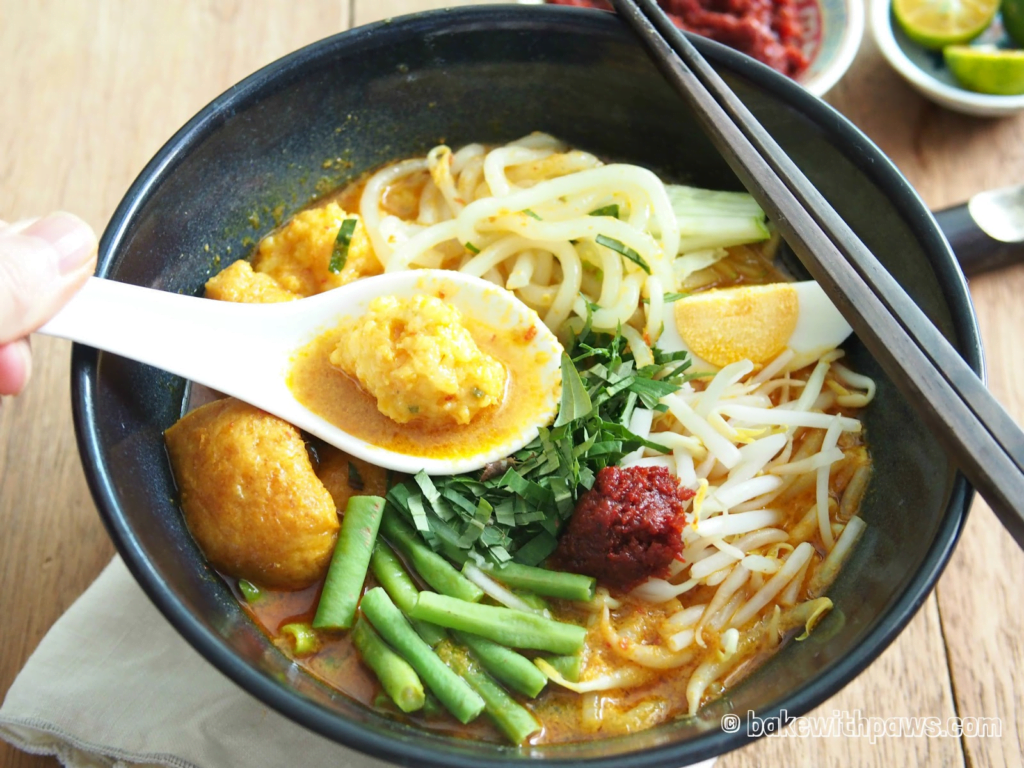
Malaysian Cuisine – Curry Laksa Ingredients
Noodles:
- Fresh or dried thick rice noodles or vermicelli.
Proteins:
- Prawns.
- Chicken – sliced or shredded.
- Fish cake – sliced.
- Cockles (optional).
Spice Paste (blended):
- Shallots.
- Garlic.
- Fresh red chilies.
- Dried red chilies (soaked).
- Lemongrass.
- Turmeric.
- Galangal.
- Candlenuts (can substitute with macadamia nuts).
- Belacan (shrimp paste) – toasted.
Broth:
- Coconut milk.
- Chicken stock or water.
- Tofu puffs.
- Bean sprouts.
- Calamansi limes.
- Salt & sugar to taste.
Garnish:
- Fresh coriander.
- Spring onion.
- Sambal (chili paste).
Malaysian Cuisine – Curry Laksa Cooking Method
- Blend the spice paste ingredients until smooth.
- In a pot, sauté the spice paste until fragrant.
- Add chicken stock or water, followed by coconut milk. Bring to boil.
- Add chicken slices and prawns.
- Simmer until the proteins are cooked.
- Season with salt and sugar.
- To serve, place noodles in a bowl, pour the creamy broth over, and top with tofu puffs, fish cakes, cockles (if using), and bean sprouts. Garnish with herbs, a slice of calamansi lime, and a spoonful of sambal.
Both versions of Laksa have their unique taste and are equally delightful. Enjoy your culinary journey into Malaysian cuisine!
Malaysian Cuisine Desserts – Cendol

Cendol is a classic Malaysian dessert that’s both refreshing and delightful, especially on a hot day. It comprises worm-like green rice flour jelly, coconut milk, palm sugar syrup, and shaved ice. There can be regional variations with additional toppings, but the essence remains the same.
Malaysian Cuisine Desserts – Cendol Ingredients
Cendol (Green Rice Flour Jelly):
- 200g rice flour.
- 20g mung bean flour or cornstarch.
- A pinch of salt.
- Pandan juice (from about 10 pandan leaves) – for natural green color and flavor. You can blend the leaves with water and strain to get the juice.
- 800ml water.
Palm Sugar Syrup (Gula Melaka):
- 250g palm sugar (gula melaka), chopped.
- 100ml water.
- A pinch of salt.
Coconut Milk:
- 500ml thick coconut milk.
- A pinch of salt.
Shaved Ice.
Optional Toppings:
- Red beans (cooked).
- Sweet corn.
- Glutinous rice.
- Grass jelly (cincau).
Malaysian Cuisine Desserts – Cendol Ingredients Cooking Method
Preparing Cendol:
- In a bowl, combine rice flour, mung bean flour (or cornstarch), and salt. Gradually add the pandan juice and water, mixing to form a smooth batter.
- Prepare a pot of boiling water. Also, prepare a bowl of cold water and set aside.
- Use a cendol press or a slotted ladle to press the batter, so it drops into the boiling water and forms the worm-like cendol shapes. If using a ladle, push the batter through the holes of the ladle.
- Once the cendol floats to the surface (indicating it’s cooked), remove it with a slotted spoon and immediately plunge it into the cold water. This stops the cooking and ensures a nice, chewy texture.
- Drain and set aside.
Palm Sugar Syrup:
- In a pot, combine the chopped palm sugar, water, and a pinch of salt. Heat and stir until the sugar has fully dissolved. Once it’s melted into a syrup, remove from heat and set aside.
Coconut Milk:
- In a separate pot, heat the coconut milk with a pinch of salt. Ensure you don’t boil the coconut milk; just heat it. Once heated, remove from the stove.
Assembling the Cendol:
- In a bowl or glass, add a good amount of shaved ice.
- Add the cendol (green rice flour jelly) on top.
- Pour the warm palm sugar syrup over the ice and cendol.
- Drizzle with the salted coconut milk.
- Add any of the optional toppings if desired.
Malaysian Cuisine Desserts – Bubur cha-cha

Bubur Cha-Cha is a vibrant and hearty Malaysian dessert that combines a variety of sweet ingredients, typically served in a warm or cold coconut milk soup. The colorful array of ingredients makes this dessert visually appealing, and it’s traditionally associated with festivities and special occasions.
Malaysian Cuisine Desserts – Bubur cha-cha Ingredients
Starchy Ingredients:
- Sweet potatoes (a mix of yellow, orange, and purple varieties): Peeled and diced into bite-sized pieces.
- Taro (yam): Peeled and diced into bite-sized pieces.
- Black-eyed peas: Soaked overnight and boiled until tender.
Jellies:
- Sago pearls: Boiled until translucent.
- Cendol (green rice flour jelly): You can buy these pre-made or prepare them from the previous recipe I provided.
- Agar-agar jelly: Cut into small cubes or strips. You can use various colors, but pink and clear are traditional.
Coconut Milk Broth:
- Coconut milk: About 1 liter or to taste.
- Palm sugar (gula melaka): To taste. Adjust based on desired sweetness.
- White sugar: Optional, to adjust sweetness if needed.
- Pandan leaves: Tied into a knot, for aroma.
- Salt: A pinch, to enhance the flavors.
Optional:
- Bananas: Some versions include small banana pieces, like the “pisang emas” variety.
- Jackfruit strips: For added fragrance and texture.
Malaysian Cuisine Desserts – Bubur cha-cha Cooking Method
Preparing the Starchy Ingredients:
- Boil the diced sweet potatoes and taro until they are just tender. Avoid overcooking as they can become mushy. Drain and set aside.
- Cook the black-eyed peas until they are tender. Drain and set aside.
Preparing the Jellies:
- Cook the sago pearls as per package instructions, usually until they become translucent. Rinse under cold water to remove excess starch and set aside.
- Prepare the cendol and agar-agar jellies if you haven’t bought them pre-made.
Coconut Milk Broth:
- In a large pot, add coconut milk, pandan leaves, palm sugar, a pinch of salt, and white sugar (if using).
- Stir gently over low to medium heat. Ensure the coconut milk doesn’t boil vigorously as it can curdle.
- Once the sugar has dissolved and the broth is hot, you can taste and adjust the sweetness.
Assembling Bubur Cha-Cha:
- Add the cooked sweet potatoes, taro, black-eyed peas, sago pearls, cendol, and agar-agar jellies into the coconut milk broth.
- If you’re using bananas, add them just before serving to ensure they don’t become too mushy.
- If using jackfruit, add them in at this stage.
- Stir gently and heat until everything is well-combined and warmed.
Serving:
- Bubur Cha-Cha can be served warm or chilled. If you prefer it chilled, refrigerate for a few hours before serving.
- Garnish with additional slices of jackfruit or a sprinkle of sago pearls if desired.
Enjoy your hearty and colorful Bubur Cha-Cha as a delicious treat or a festive dessert!
Street Food in Malaysia
Malaysian streets are culinary wonderlands. From Penang’s ‘Asam Laksa’ to Kuala Lumpur’s ‘Ikan Bakar’, every alley offers a unique flavor.
Dishes like ‘Satay’, skewered and grilled meat served with peanut sauce, ‘Roti Canai’, a flaky bread paired with dhal, and ‘Teh Tarik’, a strong tea with condensed milk, are integral to Malaysia’s street food culture.
Conclusion
To partake in a Malaysian meal is to journey through its history, culture, and heart. Each dish, whether served in a posh restaurant or a humble street stall, tells a story. A story of migration, trade, colonization, and the indomitable spirit of its people who turned every influence into a culinary masterpiece.
A Delectable Q&A Session
What distinguishes Malaysian cuisine from other Southeast Asian cuisines?
Malaysian cuisine is a melting pot of culinary influences, primarily Malay, Chinese, and Indian, but also Thai, Javanese, and Sumatran. This unique blend creates a harmonious fusion of flavors, techniques, and ingredients, setting it apart from its Southeast Asian neighbors.
What is Malaysian Food Culture?
Malaysian food culture is a vibrant blend of Malay, Chinese, and Indian influences. Known for its diverse flavors and spices, Malaysian cuisine offers a wide range of dishes such as nasi lemak, char kway teow, and roti canai.
The country’s food culture reflects its multicultural heritage and is a reflection of its people’s love for delicious and hearty meals.
Which dish is considered Malaysia’s national dish?
‘Nasi lemak’ is often touted as the national dish. Traditionally, it comprises fragrant rice cooked in coconut milk, served with spicy sambal, crispy anchovies, roasted peanuts, boiled egg, and cucumber.
How has street food Influenced Malaysian Culinary Culture?
Street food, or ‘hawker food’, is integral to Malaysian culture. Cities like Penang are renowned for their vibrant hawker scenes. These stalls have preserved traditional recipes, provided affordable meals, and become hubs of social interaction, making street food an essential thread in the Malaysian culinary tapestry.
Are there any specific etiquettes one should follow when dining in Malaysia?
Yes. Using the right hand to eat (especially when using hands for dishes like ‘roti canai’ or ‘banana leaf meals’) is a common practice. Also, removing shoes when entering someone’s home and waiting for elders to start the meal are signs of respect.
What’s the significance of festivals in Malaysian cuisine?
Festivals dictate culinary calendars in Malaysia. Whether it’s Hari Raya, Chinese New Year, or Deepavali, each celebration brings with it specific dishes and culinary rituals, reflecting the multicultural fabric of the country.
How do spices play a role in Malaysian dishes?
Spices are the soul of Malaysian cuisine. From the fiery ‘cili padi’ (bird’s eye chili) to the aromatic ‘bunga kantan’ (torch ginger flower), spices impart depth, heat, and complexity to dishes, making them distinct and flavorful.
Can vegetarians enjoy Malaysian cuisine?
Absolutely! While many Malaysian dishes include meat or seafood, there’s a plethora of vegetarian options, influenced heavily by Indian and Chinese cuisines, like ‘sayur lodeh’ (vegetable coconut curry) and ‘tau fu fa’ (silken tofu dessert).


WOW